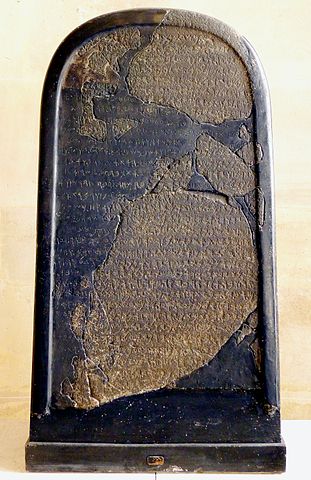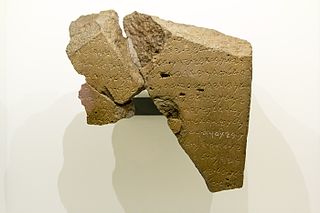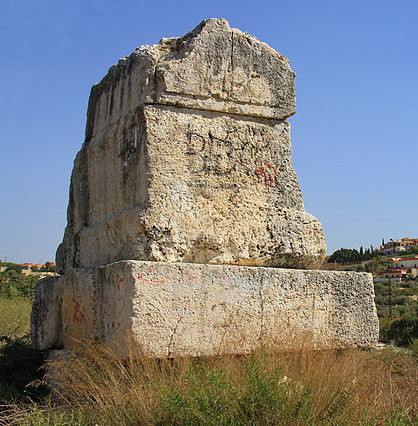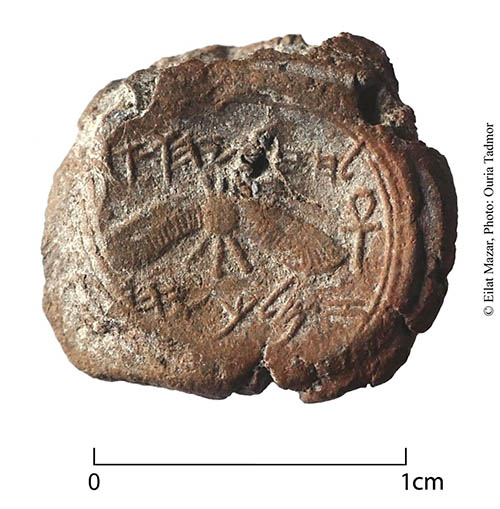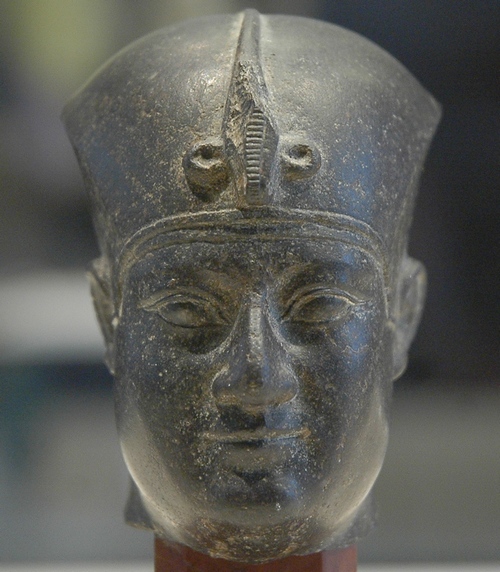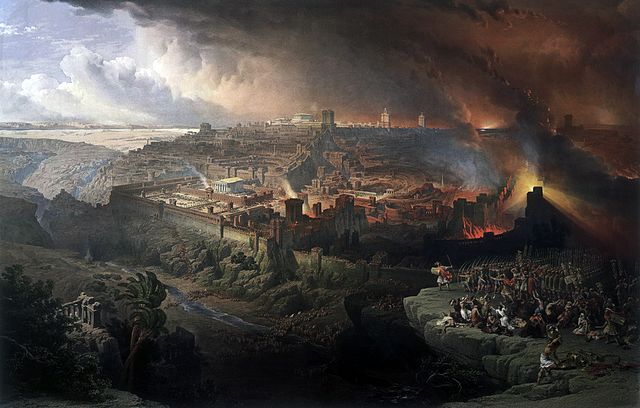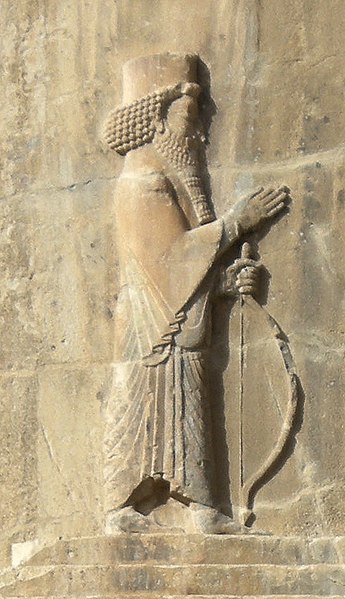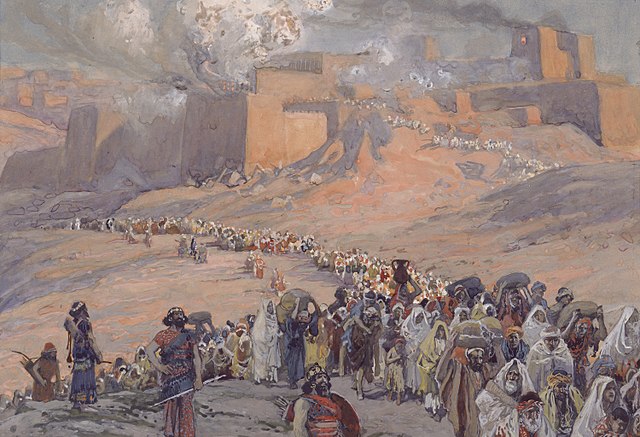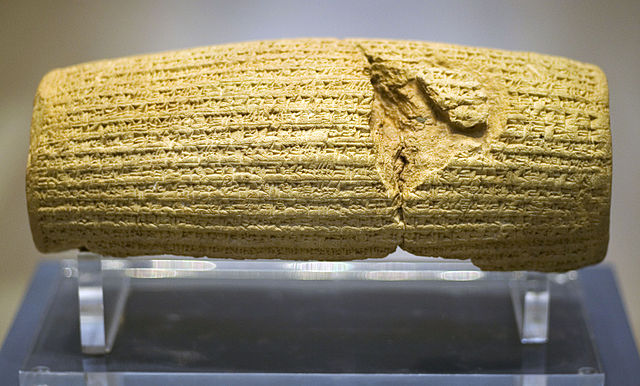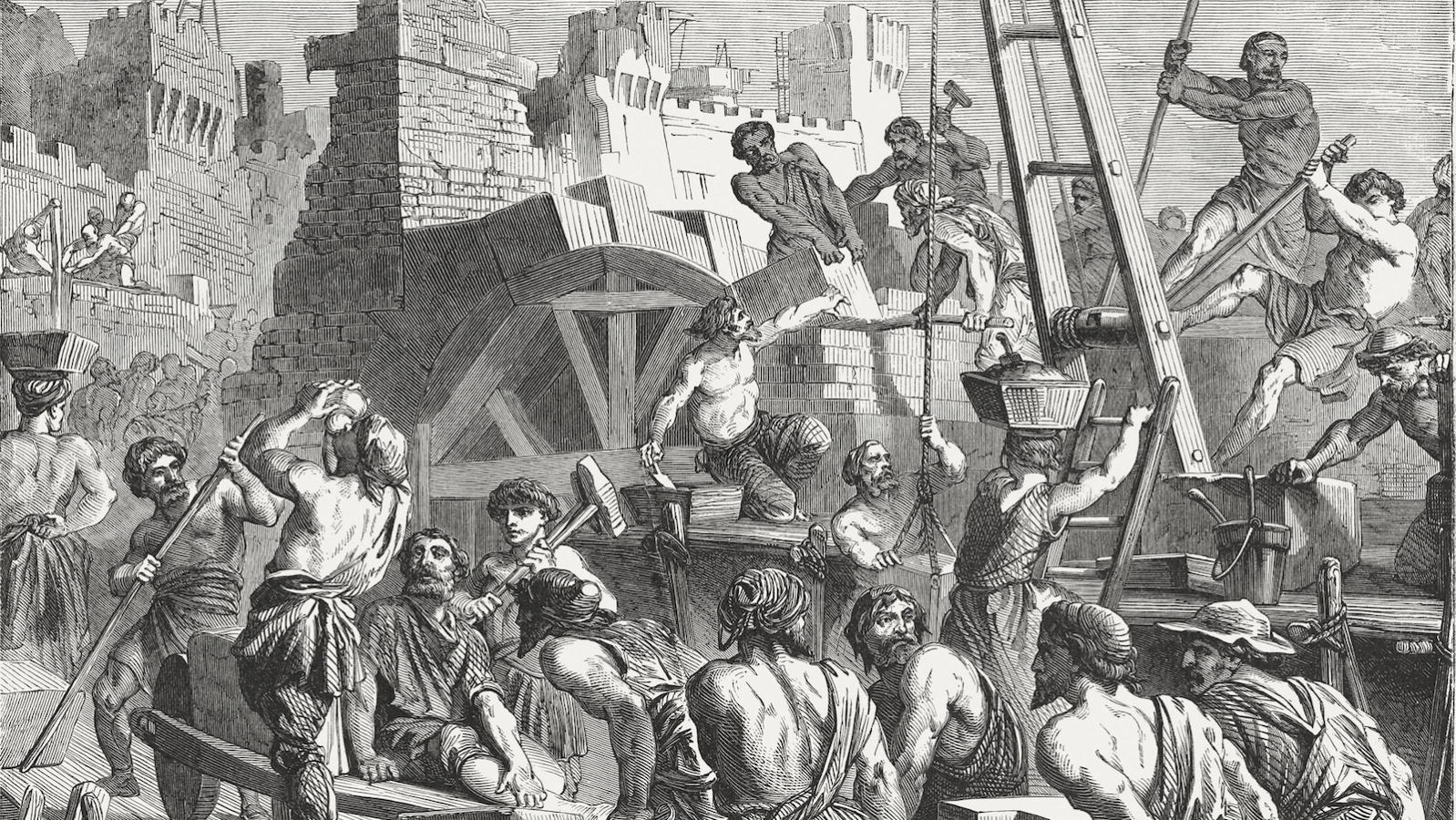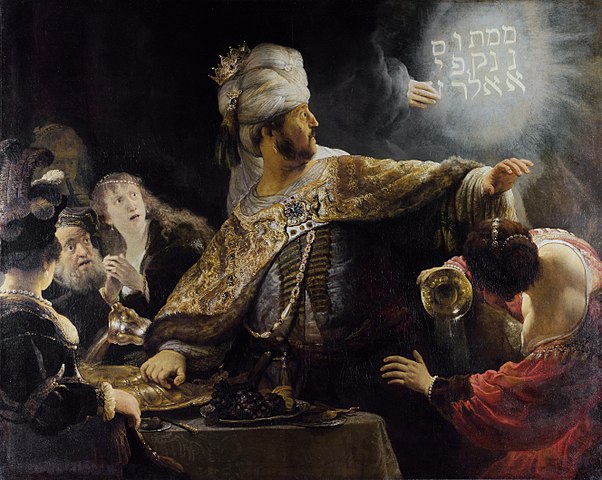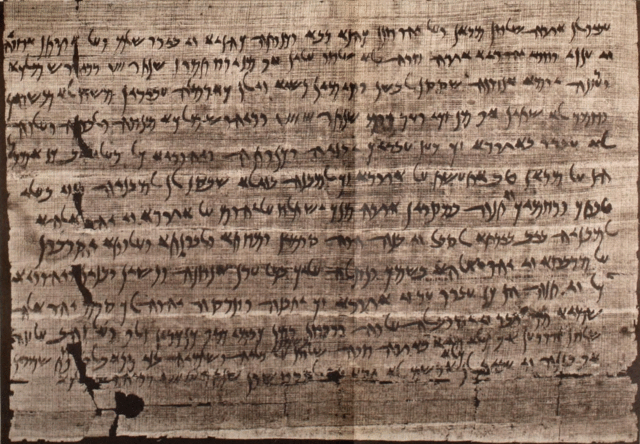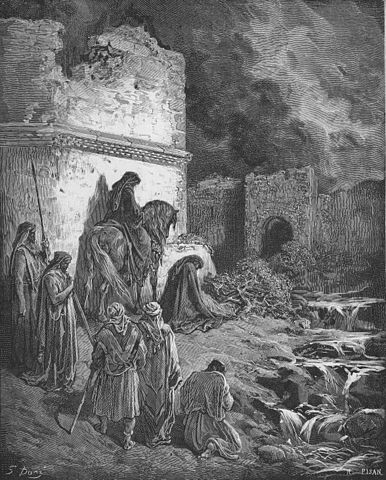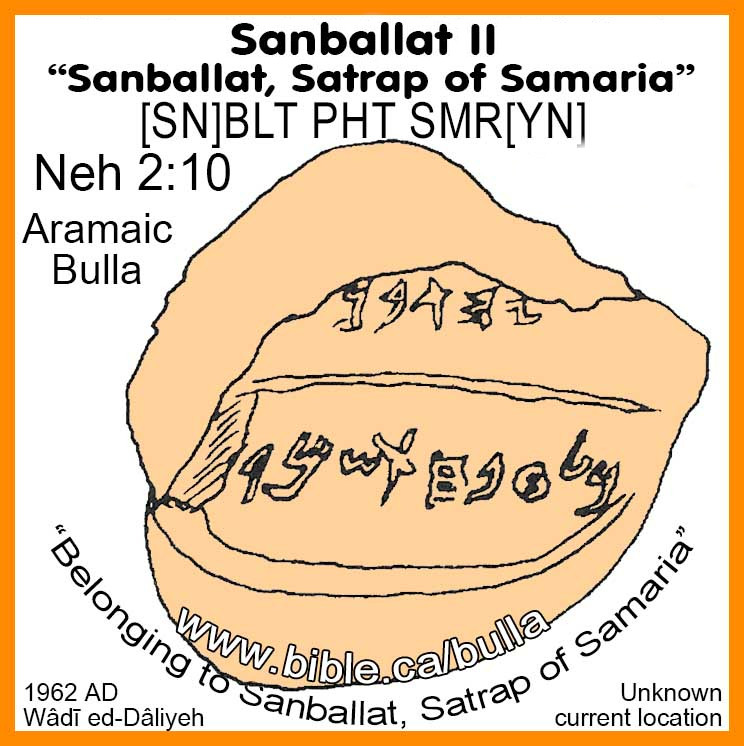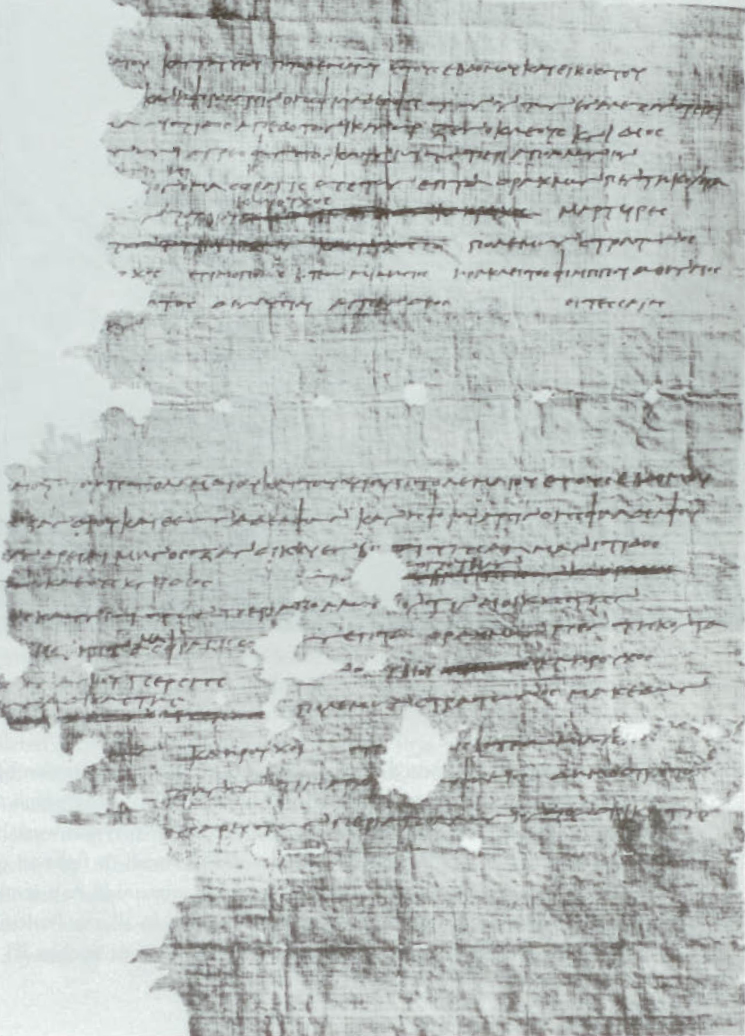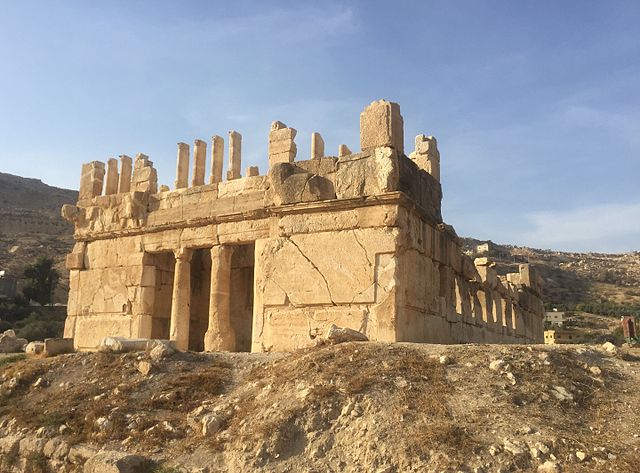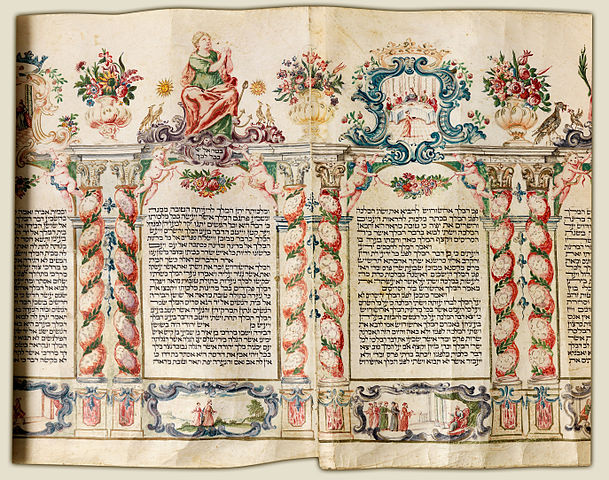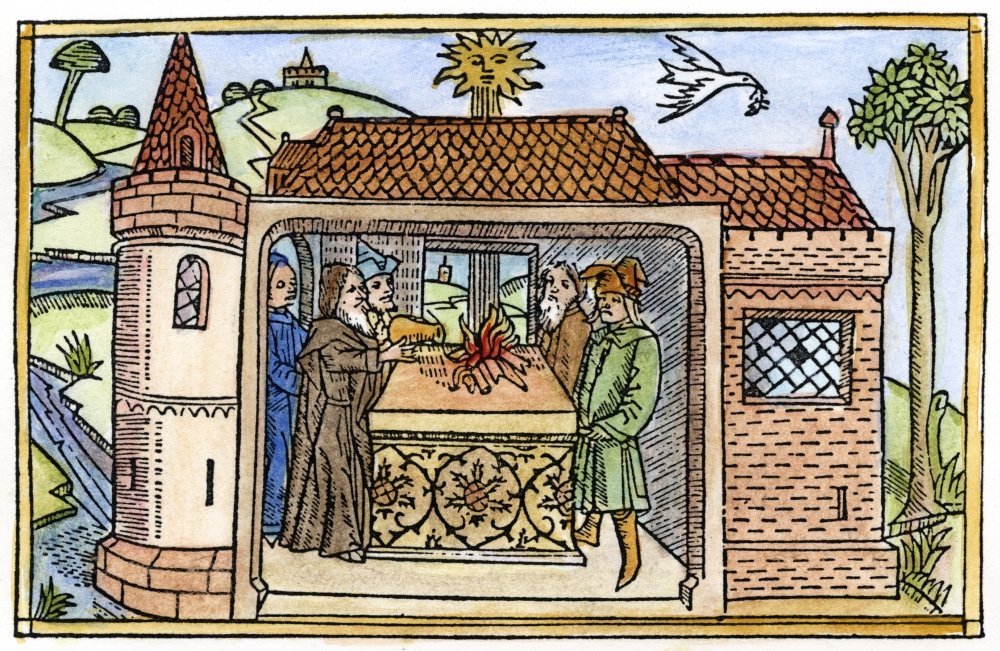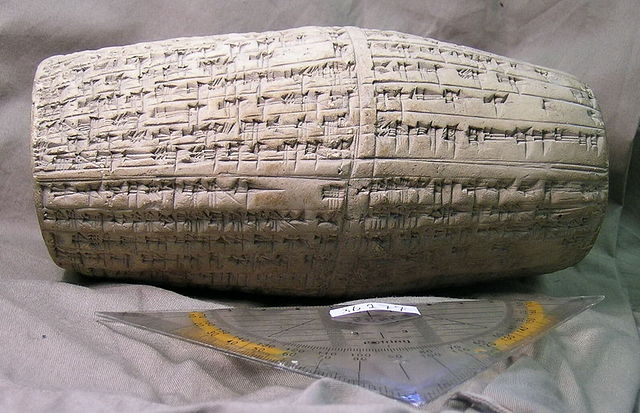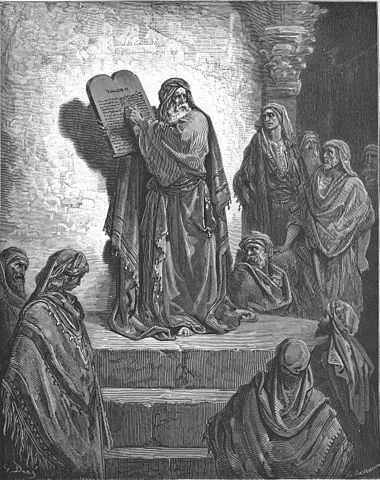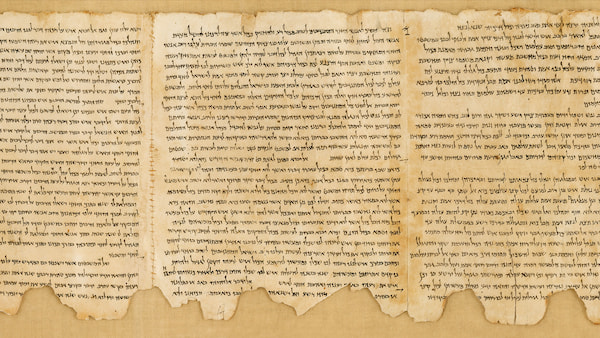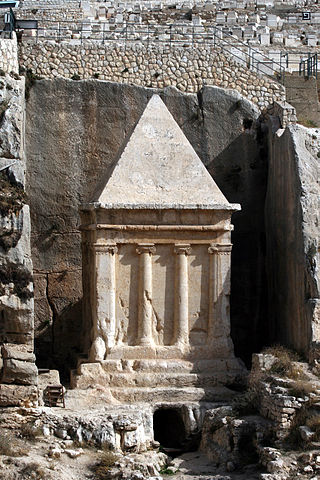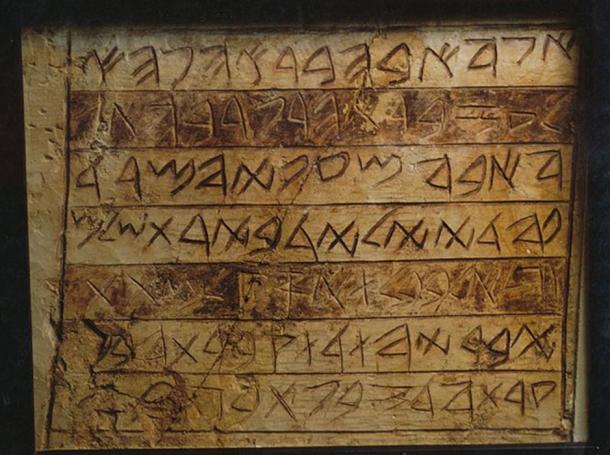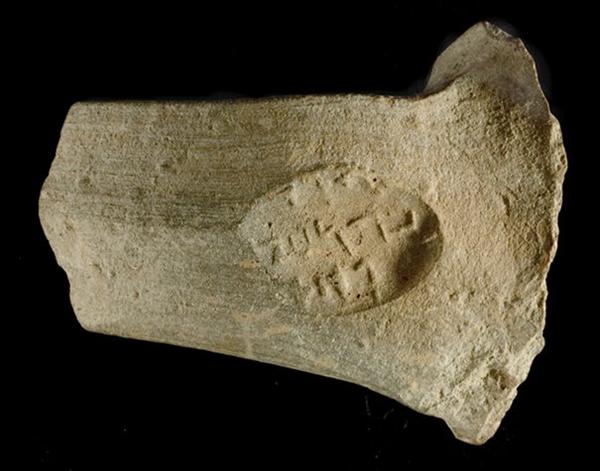Outlines for a New Chronology of Ancient Jewish History
For many centuries, numerous attempts have been made to answer questions concerning the origin of the Jewish Bible, its authenticity, and its value as a historical source. The "Traditional Chronology" of ancient Jewish history from the Biblical period has presented a serious conundrum for historians seeking to reconcile existing information sourced from well- known Biblical books with the rapidly growing archaeological database. This current paper attempts to address some of these issues with a radical approach that moves the traditional timeline forward by almost 250 years. This "New Chronology" inevitably leads to a significant reconsideration of the validity of the events and historical figures described in the Bible.
1. Josephus Flavius and the Origin of the Traditional Chronology
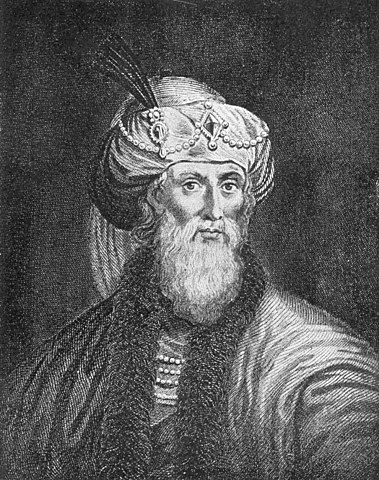
Josephus Flavius
The Traditional Chronology of ancient Jewish history that is generally accepted today was first postulated by Josephus Flavius in his book - The Jewish Antiquities. Josephus, a Jewish historian writing in the Roman period, during the late-1st century AD, sought to celebrate the characters mentioned in the Bible, and by dating the events as far back in history as possible, he was able to idealize Jewish history and present the Jews as an ancient nation. Although he had access to the books written by the Greek historians from the Classical period, with accounts about of the Persian kings and their wars with the Greeks, these sources did not contain any material relating to the history of the Jews from before c. 300 BC. Josephus was apparently totally unaware of any Persian historical sources and relied on limited access to the Greek literature of the Hellenistic period that did not pay much attention to the subject of the Jews.
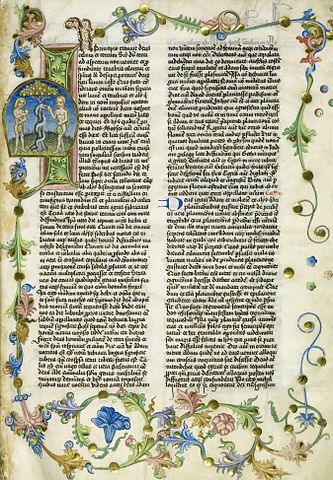
A leaf from the "Jewish antiquities"
In response to his contemporary critics, Josephus acknowledged that when he wrote his book, he had relied on the Biblical Books of Kings as his primary source of information concerning ancient Jewish history. He, therefore, described the historical events exactly as they were recorded in the Bible and presented their chronology according to his understanding of their sequence. Following Josephus's timeline, it has been widely accepted that the end of the Kingdom of Judea and the exile of the majority of its population was caused by the military actions of the famous ruler of the Neo-Babylonian Kingdom, King Nebuchadnezzar II (605-562 BC). Since the Bible states that the two exiles of the Judeans by the Babylonians occurred in his seventh and eighteenth years, with the destruction of the Temple happening in his nineteenth year, the exiles have been dated to 598 and 587 BC and the destruction of the Temple to 586 BC.
Information relating to the return of the Jews from the Babylonian exile and their subsequent rebuilding of the Temple in Jerusalem is contained in the Biblical Books of Ezra and Nehemiah. The Book of Ezra recounts that the first group of Jewish returnees from Babylon arrived with the Persian Governor of Judea, Zerubbabel, and Priest Joshua, and that they started rebuilding the Temple in the second year of King Darius’ s reign. The Book of Nehemiah preserves the text of the Memoirs of Nehemiah, an original account of his building activities in Jerusalem, written in the first person by Nehemiah himself. Nehemiah, who was appointed by the Persian King Artaxerxes to be the Governor of Judea, came to Jerusalem from Susa in the twentieth year of his reign, accompanied by a group of Persian Jews. Another group returned from Babylon with Ezra during the seventh year of King Artaxerxes’s reign. Although the figures of Nehemiah and Ezra were placed in the same timeframe by the later editor of the Book of Ezra-Nehemiah, which of them came first remains a subject of debate.
Josephus positioned the return of the Jews in the early Achaemenid period, placing Zerubbabel in the reign of King Darius I (522-486 BC), and Ezra and Nehemiah in the reign of King Xerxes (486-465 BC). Incidentally, the name of Xerxes is not mentioned in the Biblical text, but he was certainly known to readers of The Histories by Herodotus, that cast serious doubt on the identification of the Biblical king Artaxerxes as the Achaemenid King Xerxes. Dating the Babylonian exile and the Temple's destruction to the beginning of the 6th century BC has been almost universally accepted by scholars but, despite numerous attempts, establishing an accurate date for the return of the Jews has proved more elusive. Many scholars have chosen later dates, such as the reigns of King Artaxerxes I (465-424 BC) or King Darius II (423-404 BC), and thus attempts have been made to fix the dates of Nehemiah's and Zerubbabel's arrivals in the years 445 and 422 BC, respectively. More recently, however, other scholars have started to question the historicity of the return itself. By placing the characters and the events described in Ezra-Nehemiah in the early Achaemenid period, Josephus created a significant chronological gap between the middle of the 5th and the beginning of the 2nd century BC, not only in Jewish history but also in Jewish literature. This apparent dearth of information, from the return of the Jews right up until the Seleucid conquest of Judea in 200 BC, creates an exceptionally lengthy period for the ancient Jewish "Dark Ages". It is hard to believe that no significant events whatsoever occurred in Judea during this entire period; it is even more difficult to accept that the Jews stopped recording their own history for almost 250 years!
2. A Challenge to the Traditional Chronology
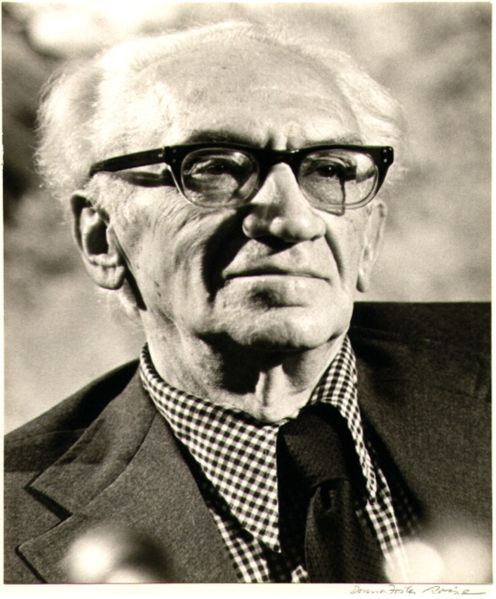
Photographer: Donna Foster Roizen. Copyright holder: Frederic Jueneman [CC BY-SA 3.0], via Wikimedia Commons
Immanuel Velikovsky
The chronology of ancient Jewish history that Josephus put forward was not unanimously accepted, even in ancient times. For example, in the 2nd century AD, a rabbinical chronicle, Seder Olam Rabbah, presented a different chronological order and stated that the Persian period lasted for 34 years and that the Second Temple of Jerusalem had stood for 420 years. An Egyptian scholar, Apion, wrote a book that disagreed with Josephus's chronology, and Josephus responded with his booklet Against Apion. In general, however, modern scholars of Jewish history have continued to use Josephus’ chronology, thereby maintaining the traditional timeline.
This Traditional Chronology was first challenged by Immanuel Velikovsky an American scholar of Russian Jewish origin, in his book entitled, Ages in Chaos, first published in New York in 1952 (36). Velikovsky suggested an alternative approach for examining the chronology of the history of the Ancient Near East and proposed reviewing the entire history of the region using the concept of "ghost-doubles" or alter-egos. These were historical figures that appear with different identities in different sources; they were thought to have lived in different periods but were, in fact, the same people with the accounts and events concerning them wrongly dated by previous generations of scholars. This approach allowed him to propose a "short" chronology of ancient Egyptian history, bringing forward the Eighteenth Dynasty of Egypt by about six hundred years and setting the timeframe of the Exodus in the 10th century BC, and the United Monarchy of Solomon in the 8th century BC. In this way, Hatshepsut, the Queen of Egypt from the Eighteenth Dynasty, became a contemporary of King Solomon, and could be identified as the Queen of Sheba.
More recently, a British Egyptologist, David Rohl, revisited the available Egyptian sources and created a New Chronology of Ancient Egypt; he attempted to match the chain of events described in the Bible with available archaeological data and to identify some of the Biblical characters with people whose names appear in archaeological finds (31). He suggested removing the period of the "Dark Ages" of Egyptian history by re-dating the historical events and bringing them forward from the 13th century BC to the 10th century BC. He also re-dated the Egyptian kings of the 19th through the 25th Dynasties, bringing forward the conventional dating by about 300-350 years, and equating the Biblical figure of the Egyptian Pharaoh Shishak, who sacked Jerusalem after the death of King Solomon, with Ramesses II of the Nineteenth Dynasty.
Another theory was developed by the German scholar Gunnar Heinsohn who proposed radically re-dating the entire Neo-Assyrian period, the 9th-7th centuries BC (20). He based his conclusions on a positive identification of Neo-Assyrian rulers with the Persian kings of the Achaemenid period. Using observations of the stratigraphy of many archaeological sites in North Mesopotamia, he noted that the "Achaemenid" stratum is entirely missing from these, and thus came to the controversial conclusion that the "Neo-Assyrian" period should be equated with the "Achaemenid" period. The British historian Emmett Sweeney continued with a similar theory, arguing that all the rulers known in history as Neo-Assyrian and Neo-Babylonian kings were, in fact, the Great Kings of the Persians under the guise of Mesopotamians (35). He proposed that Tiglath-Pileser III should be identified with Cyrus the Great, founder of the Achaemenid dynasty, and that the Neo-Assyrian and the Neo-Babylonian kings who followed him should be identified with the Achaemenid kings who succeeded Cyrus: thus Shalmaneser was equated to Cambyses; Sargon to Darius I; Sennacherib to Xerxes; Esarhaddon to Artaxerxes I; Ashurbanipal to Darius II; Nabopolassar to Artaxerxes II; Nebuchadnezzar to Artaxerxes III; and Nabonidus to Darius III. Assuming the timeline of Sweeney is correct, it would follow that the Jews were taken to Babylon by Artaxerxes III Ochus, shortly before the destruction of the Achaemenid Empire. If this is the case, when did they return from the exile and what were the identities of the Persian kings, Artaxerxes and Darius, mentioned in Ezra-Nehemiah?
While most Israeli historians have remained faithful to the traditional timeline, some archaeologists, including Israel Finkelstein from Tel Aviv University, are more sympathetic to re-evaluating the conventional chronology. Finkelstein claims that none of the ancient sites of Northern Israel preceded the 9th century BC and that the United Monarchy of David and Solomon that was traditionally dated to the 10th century BC, is a myth (12). More recently, Finkelstein published a series of studies collected in his book, Hasmonean Realities Behind Ezra, Nehemiah, and Chronicles (13), where he proposed a radical re-evaluation of Biblical research by suggesting a Hellenistic setting for the historical events that are revealed from an analysis of these Biblical books. While recognizing that large parts of these books are of Hellenistic origin, and were presumably inserted into the older texts, for some reason he refrained from pursuing this argument further and admitting the possibility that the entire texts, and their heroes, could have been of the Hellenistic period. Could it have been a similar situation with the Biblical narrative relating to Kings David and Solomon?
3. Was there ever a United Jewish Monarchy?
The primary sources of our knowledge of the ancient Jewish history are the 2 Books of Samuel and the 2 Books of Kings, all of which were initially composed as one book and then separated at a later stage. Samuel tells the story of the Prophet Samuel in the context of the history of the "House of David" that replaced the "House of Saul". The reign of the first ruler of Judea, King Saul, has been traditionally placed by scholars in the 11th century BC. However, the inclusion of references that are thought to be anachronistic, such as the mention of chariots that did not exist before the 8th century BC, led to the suggestion that the core narrative of Samuel could have been written later, and can be used to reconstruct the history of the Kingdom of Saul if this come into being sometime in the middle of the 8th century BC. 1 Kings continues the narrative of Samuel and celebrates the period of the United Monarchy that was established after the death of King David by his son, King Solomon; it suggests that this was a period of outstanding prosperity, which was followed by a period of devastation and disorder. The narrative of Kings presents the ancient period of Jewish history as the history of two competing states – Israel and Judea – both emerging from the tragic break-up of the United Monarchy after the death of Solomon. Following the disintegration of the United Monarchy, the Kingdom of Israel was created in the north and the Kingdom of Judea was established in the south, around Jerusalem. According to the Traditional Chronology, both Kingdoms came into being c. 930 BC, and although Northern Kingdom ceased to exist in 722 BC, the Southern Kingdom survived until 587/6 BC.
During the last few decades, Israeli archaeologists have carried out extensive excavations of many ancient sites. One of the most fascinating results is the total absence of archaeological layers that can be securely dated to the period from the 10th century BC, the traditionally accepted timeframe for the United Jewish Monarchy. The large public structures which have been excavated in the towns of Northern Israel only date from the 9th to the mid-8th century BC and provide examples of architecture of the Kingdom of Israel, but there is no trace of large government buildings that could possibly be associated with the supposed reigns of either King David or King Solomon (11; 12). These excavated structures are believed to have fallen out of use and to have been abandoned as a result of the Assyrian invasion of Northern Israel that occurred in 733/2 BC, and brought an end to the Kingdom of Israel, although there is no definitive evidence to support this conclusion as the kings of Israel left no records similar to the monumental cuneiform inscriptions of the Assyrian kings.
It is, perhaps, strange that the earliest epigraphic evidence of Judea as an independent political entity comes from Assyrian inscriptions from the time of Tiglath-Pileser III (745-727 BC); these include a brief mention of Judea in the lists of the small kingdoms of the Eastern Mediterranean that were subjected to the power of the Assyrian king, in the same way as the Phoenician town-states that paid him tribute (16b). Assyrian cuneiform inscriptions of the 9th-8th centuries BC, however, do mention a political entity in Northern Israel that is often referred to as the "House of Omri". According to 1 Kings 16, King Omri was the sixth King of Israel; although he was a successful military campaigner who extended the borders of his Kingdom, he was still considered to have been an "evil" king. Clearly, for the Judean chronicler, the long-since destroyed Kingdom of Israel was no more than a "sinful kingdom"; none of its kings displayed positive characteristics, and none were worthy of God’s favour. This negative stance may be explained by their comparison to the chieftains of the Samaritans, who were contemporaries of the Judean chronicler and, as can be seen in Ezra-Nehemiah, were the primary competitors of the Judeans. This is probably why the Judean chronicler, who recorded that the city of Tirzah in Northern Israel was the capital of Omri, credited him with the construction of Samaria, which he apparently made his new capital (1 Kings 16:24). Although Thomas Thompson and Niels Lemche suggest that Omri may be a dynastic name indicating the apical founder of the Kingdom of Israel rather than denoting an actual historical king, Lester Grabbe showed that there is no reason to question the historicity of Omri, himself (17, p. 48-49). Nevertheless, his relation to Samaria remains in doubt, and the "Samaritan" identity of the ancient Israelite kings can be questioned.
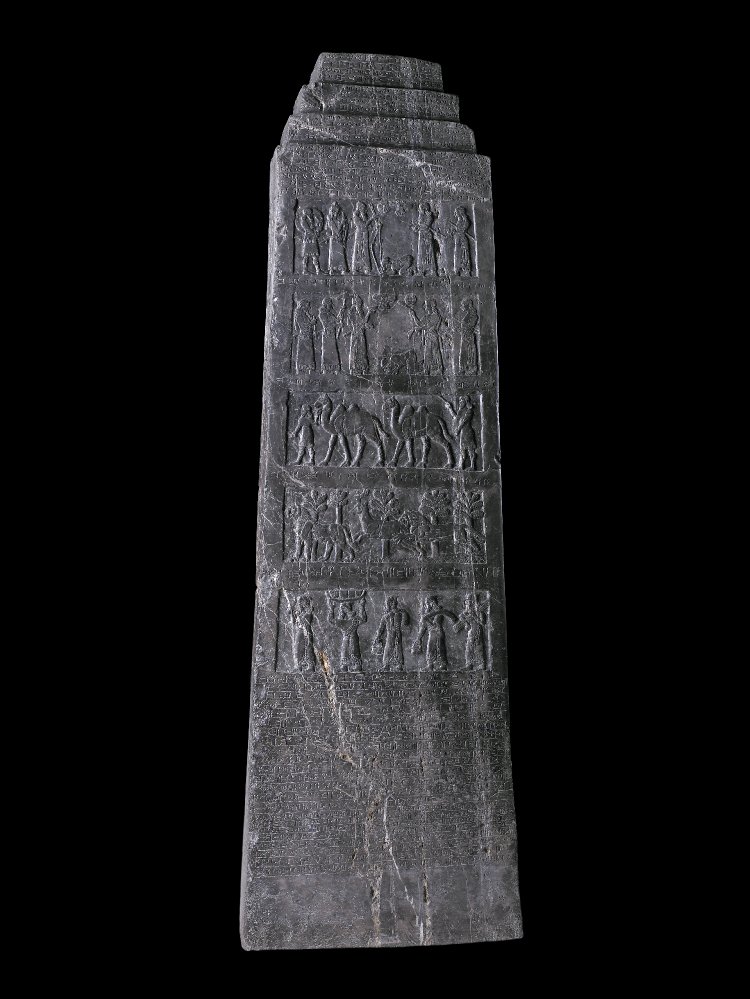
© The Trustees of the British Museum
The Black Obelisk of Shalmaneser
The events recounted in Kings relating to the history of Israel can only be regarded as of historical value if they can be confirmed by extra-Biblical sources. In this connection, the Black Obelisk of Shalmaneser III shows Jehu, the son of Omri, bringing tribute to the Assyrian king, proving that the Omrides fell under Assyrian power. The Mesha Stele, a monument set up by King Mesha of Moab, bears the most extensive inscription ever recovered in the region that specifically refers to the "House of Omri" as Israel. It recounts how Moab was oppressed by the "King of Israel, the son of Omri", and describes Mesha's victories over him. While Mesha makes no mention of Judea, 2 Kings 3 artificially brings the King of Judea, Jehoshaphat, into the story and allies him with Jehoram of Israel. This story is an example of the methods used by the author of Kings who deliberately attempted to establish the kings of Judea alongside those of Israel.
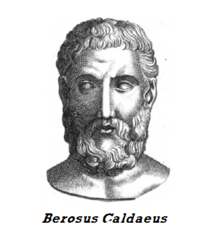
The Books of Kings must be viewed in the context of the Hellenistic historical tradition; they appear to be a very complex compilation resulting from the merging of two different categories of written sources. On the one hand were the Jewish chronicles that kept a lists of the names of the kings and the length of their reigns; on the other, the Mesopotamian cuneiform sources that evolved into the Babyloniaca, the "History of Babylonia", composed by the Seleucid Priest Berossus, and published around 278 BC. Many excerpts from this treatise are scattered among the ancient texts, such as those of Josephus, and the Greek historian Eusebius of Caesarea. It is interesting that Berossus paid attention to the Assyrian King Sennacherib and to the Babylonian King Nebuchadnezzar who was considered a model ruler by the Seleucid kings (22). Berossus' achievement may be seen in terms of how he combined Greek methods of historical narrative with the cuneiform accounts to form a unique composite that allowed him to skip the Achaemenid period in the history of Mesopotamia while focusing on the continuation between the Babylonian and the Seleucid kings.
While the methods used in Kings appear to be similar to those employed by Berossus, his ideas and his language appear to be closer to those of the Deuteronomist, the author of the Fifth Book of the Torah. While the latter focused on the unification of the cult and the centrality of Jerusalem, the former dealt with the reflection of the catastrophe that befell the Jewish nation when its Kingdom was destroyed and most of the population was sent into captivity. Kings not only accepted the timeline of Berossus’ Babyloniaca, but by using two separate lists – one detailing the kings of Israel and the other the kings of Judea – he aligned their dates in an artificial attempt to establish historical events concerning both kingdoms within the same timeframe. This approach has presented serious obstacles for historians due to the resulting inconsistencies. For example, Omri’s accession to the throne of Israel in the 31st year of Asa of Judah (1 Kings 16:23) cannot have followed the death of his predecessor Zimri in the 27th year of Asa (1 Kings 16:15). Likewise, questions arise in respect of the attempts in Kings to demonstrate the supremacy of Judea over Israel by presenting the idea that the United Monarchy, which predated the Kingdom of Israel, was centred in Jerusalem, from where it apparently ruled over the entire Land of Israel. Indeed, the current state of archaeological research supports neither the idea of the United Monarchy nor the simultaneous existence of the two kingdoms competing with one another during the same period; comparative analysis of the sources suggests that the Kingdom of Judea flourished immediately after the downfall of the Kingdom of Israel.
4. Did the Kings of Judea - Saul, David, and Solomon - ever exist?
The absence of any mention of the great Judean Kings, David and Solomon, in contemporary Assyrian and Egyptian sources has added more weight to the sceptical voices questioning the existence of the United Jewish Monarchy. The rise to power of King David, King Saul’s former favourite who betrayed him but later become his successor, is described in 2 Samuel. At first, King David ruled from Hebron but after he defeated the Jebusites he established his capital in Jerusalem. There is no firm archaeological evidence, however, to establish the dates for his reign. Excavations in Kiryat Ye’arim (the place where the Ark of the Covenant was placed by King David for safekeeping), in Hebron (the early seat of King David), and in Jerusalem (the capital city and the site of the future Solomonic Temple) have shown that all these places were, effectively, small, sparsely populated villages until the second part of the 8th century BC. Moreover, as no personal seals, bullae, or ostraca with Paleo-Hebrew inscriptions similar to these found in the settlements of Northern Israel have survived in the territory of Judea prior to that time, there is no clear evidence of a significant Jewish presence either in Jerusalem or in other Judean cities during the previous period.
The discovery of the Tel Dan Stele in 1993 might change this situation. It bears a fragmentary Aramaic inscription telling of the victory of the King of Aram, who was appointed by King Hadad, over the "King of Israel"; it also occasionally mentions his fight with bytdwd – the "House of David" (5). Many scholars have decided that this inscription might be considered conclusive evidence of the existence of the historical figure of King David. The generally accepted date for the events mentioned in the Tel Dan inscription is 9th century BC, and this inscription was suggested by Lester Grabbe that it belonged to the Aramaean King Hazael, who according to 2 Kings 8:27-29, fought with Jeroboam, King of Israel, and his ally, King Ahaziah of Judea (17, p. 54-55), however, this does not explain the reference to Hadad. In my opinion, Tel Dan Stele may refer to King Hadad the Edomite who appears to have been one of the main adversaries of King David; 1 Kings 11:14-25 relates that after the death of King David he reclaimed the throne of Edom, abhorred Israel, and reigned over Aram-Damascus. It follows that the Tel Dan inscription could have been written on behalf of his ally, King Hadadezer of Zobah, an Aramaean Kingdom in the Beqaa Valley of Lebanon, who reigned in the time of King David (2 Samuel 8; 1 Kings 23). It appears that this inscription can be dated from the period of mid-8th century BC, when the Kingdom of Israel still existed, which is why the conflict of the Aramaeans with the "House of David" is mentioned there.
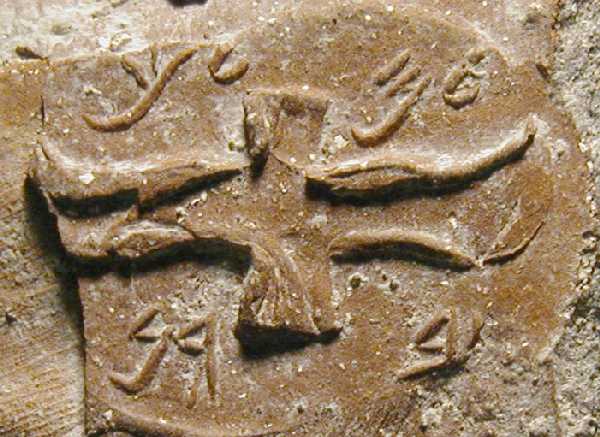
LMLK seal impression
The process of King David’s founding of Jerusalem as his new capital, must potentially have led to a massive supply of goods for the king’s court. This can be reaffirmed by many fragments from large storage jars that have been found in different cities of Judea, mainly in Lachish and Jerusalem. Dating from the second part of the 8th century BC, these have handles that were stamped with l'mlk, "for the king" and bear an image of a winged sun, a symbol of royalty in ancient Near Eastern cultures. Among them was a group with the handles sealed with l'mlk hbrn, "for the King of Hebron", confirming that David ruled Hebron prior to his conquest of Jerusalem.
Russell Gmirkin showed that the Acts of Solomon, the description of King Solomon’s activities in 1 Kings 3-11, drew heavily on the royal inscriptions of the 9th-century BC Assyrian King Shalmaneser III (16B), but although this could point to the access of Kings to the Assyrian records, it does not necessarily follow that King Solomon’s existence must be denied. Is there another way to verify the authenticity of the account in 1 Kings 6 concerning King Solomon’s building of the Temple? There is yet one more important historical personage who has been ignored by scholars – Hiram, the Phoenician king of Tyre. There was certainly a king of Tyre named Hiram who reigned in the 740s-730s BC and was listed as a tributary of the Assyrian King Tiglath-Pileser III in 738 BC. According to 1 Kings 5:1-11 and 9:10-14, Hiram became the main ally of King Solomon, sending him architects, workman, cedar wood, and gold for the building of the Temple.
The Assyrian conquest of the eastern Mediterranean in the 730s BC did not prevent the king of Tyre from exploiting his own economic opportunities. A Phoenician inscription from Cyprus confirms Hiram's control over the city of Kition (Larnaka) and his ownership of copper mines located on the coast. In addition, the Paleo-Hebrew inscription on a pottery shard found in Tel Qasila (modern Tel Aviv) and dated to the 8th century BC, noted goods sent from the "Land of Ophir" to Beit-Horon. Is this a parallel to the famous account in 1 Kings 10 concerning the joint maritime expeditions of Kings Hiram and Solomon organized to the Land of Ophir, where gold, silver, stones, and algum wood were all to be found? A letter of Qurdi-Aššur-lāmur to Tiglath-Pileser III, quotes a report from the Assyrian functionary Nabū-šēzib in Tyre, where he claims to have prevented Hiram from seizing a sacred tree from Sidon (25, pp. 185-8). Is this story of the attempted felling of a tree related to Hiram’s help in supplying the cedar trees used for building the Temple? If so, this suggests that both King Hiram and King Solomon were active at approximately the same time, and that the process of the construction of the First Temple began in the 730s BC.
5. When did the Exile of the Israelites and Samaritans take place?
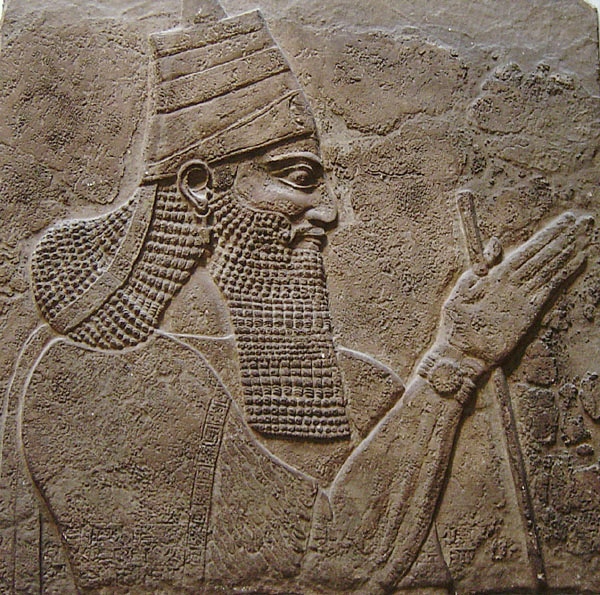
Tiglath-Pileser III
The destruction of the Kingdom of Israel came about because of two attacks by the Assyrians both described in 2 Kings. 2 Kings 15:29 relates that the first attack was carried out by Tiglath-Pileser III and resulted in the defeat and death of King Pekah from the House of Omri and the capture of a number of cities including Ijon, Abel-beth-Maachah, Janoah, Kedesh, Hazor, Gilad and Galilee, including the Land of Naphtali; most of the inhabitants were sent into exile in Assyria. This first attack was mentioned in the Assyrian inscriptions which record that the Assyrians had Pekah removed for disloyalty and replaced him with Hoshea. These events are arguably set around 733 BC, at the same time that Tiglath-Pileser III conquered Phoenician cities, took Damascus, and exiled many Aramaeans.
1 Kings 9:13 reports that, as repayment for King Hiram’s help, King Solomon handed him the district of Kabul, which contained the "empty towns" of Galilee. Bearing in mind that after the invasion of the Assyrians into north-west Galilee in 733/2 BC there was a great deal of devastation to that area and the towns of Northern Israel were left empty; this would seem to suggest that the area was transferred to Hiram around 730 BC. But what happened to the Israelites who were not deported by the Assyrians? The best answer is that they established Samaria, which became a new hub in the central highlands; however, it is also possible that some people were able to flee south to the sub-mountainous areas that surrounded Jerusalem. If this was the case, the significant shift in the demographics of Judea during the last third of the 8th century BC might have happened due to the mass migration of the Israelites. The fact that both the Samaritans as well as the Judeans continued to use the same Paleo-Hebrew script that at first spread in the North, is strong evidence of their ethno-cultural continuity.
The account in 2 Kings 15:30 does not end with the death of King Pekah but goes on to describe the rise to power of King Hoshea, the son of Elah (732-23 BC), who was apparently unrelated to the Omrides dynasty. The second Assyrian attack on Samaria, launched by King Shalmaneser, is also described in 2 Kings 17:1-5. The city of Samaria was besieged after the Assyrians discovered that Hoshea had been sending gifts to the Egyptian King So, who was identified as Pharaoh Osorkon IV (730-15 BC). His help never materialised, and after the fall of Samaria, Hoshea was imprisoned. The next verse adds that an Assyrian king sent the Samaritans into exile in "Halah and in Habor by the river of Gozan, and into the Median cities". These people, lost in captivity, became known as the Ten Lost Tribes.
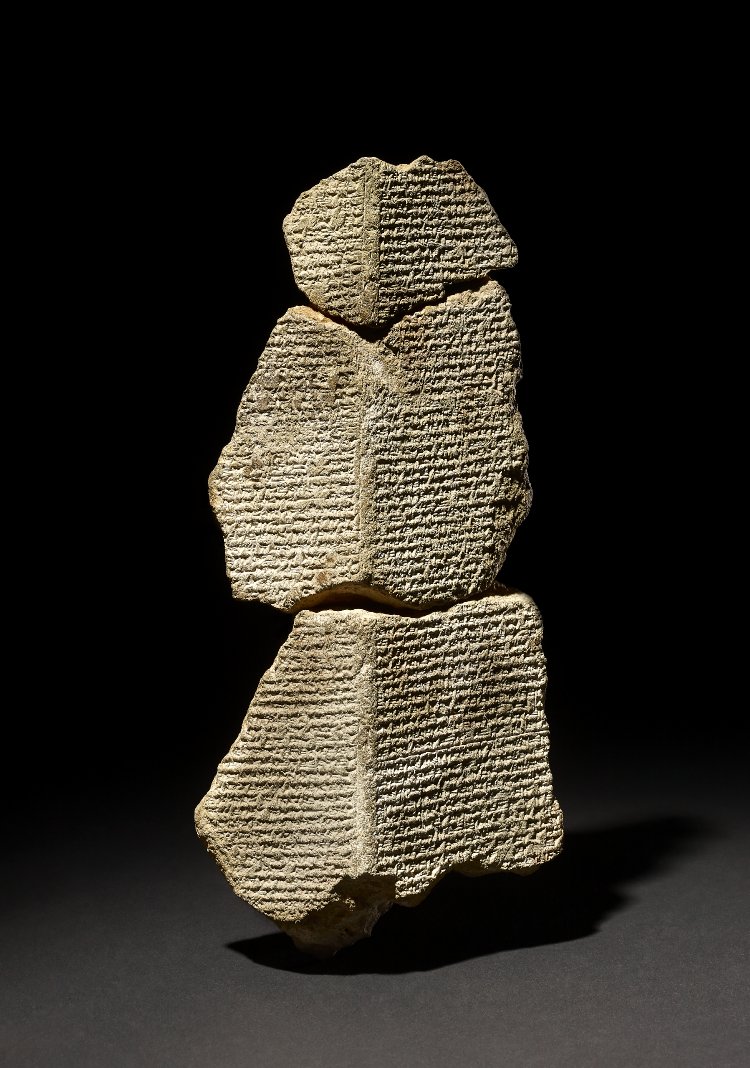
© The Trustees of the British Museum
Fragment of a clay prism with Annals of Sargon II
The Traditional Chronology dates the deportation of the Samaritans to 722 BC, the last year of the reign of King Shalmaneser V (727-722 BC), which corresponds to the data of the Babylonian Chronicle I:1:28 stating that Shalmaneser V "ruined" Šamara’in (Samaria). However, as no mention of the Samaritan exile has been found in inscriptions from the Assyrian capital of Nineveh, it has been suggested that any involvement of Shalmaneser V in these events can be regarded as speculative (40). The events relating to the fall of Samaria were recorded in eight cuneiform sources, all authorized by King Sargon. The Annals of Sargon were recorded on a clay prism and recounted that, in the beginning of his rule, after the conquest of *Samarina, some 27, 290 people were deported. The inscription from a stele in the castle of Khorsabad claimed that, in his seventh year King Sargon brought new settlers into Samaria who originated from different Arab tribes. This contradicts 2 Kings 17:24, which relates that the colonists arrived from the cities of Babylon, Cuthah, Avva, Hamath, and Sepharvaim. Surprisingly, no mention of King Sargon, the king of Asshur, has ever been found in Nineveh, with the result that for a very long time he was unknown. His name was, however, briefly mentioned in Isaiah 20:1-2 in connection with the Assyrian General Tartan’s capture of Ashdod. Although there is no evidence in the Bible to connect the expulsion of the Samaritans with Sargon II, the information from the Annals of Sargon has been commonly accepted as proof that he did, indeed, send the Samaritans into exile. It would seem more likely, however, that the data recorded by Sargon relates to historical events that occurred in some later period.
What was the identity of the king who ordered the exile of the Samaritans? Although Sweeney suggested identifying Sargon II with the Achaemenid King Darius I the Great, who reigned in 522 - 486 BC (35, p. 123-7), in my opinion, Sargon is the dynastic name of the Achaemenid King Xerxes (486-65 BC) and honours the ancient legendary king of Akkad, Sargon I; this would mean that the events relating to the fall of Samaria took place in the seventh year of his reign. After the excavation of Khorsabad Castle, it was suggested that it had once belonged to the Assyrian King Sargon II, although it would seem more likely that the castle of Khorsabad, in fact, belonged to Xerxes, as no other archaeological traces of this great king were found in the excavations of the Achaemenid capital Persepolis. This identification has led to the suggestion that the narrative of 2 Kings conflates memories of two different events: one – the destruction of the Kingdom of Israel that occurred in the Assyrian period, and the other – the conquest of Samaria that took place in 479 BC, in the Achaemenid period.
6. When were the reigns of Hezekiah and Josiah, the Kings of Judea?
According to 2 Kings 18, King Hezekiah was the fourteenth king of Judea, and the only one after the ancient great kings of the United Monarchy, David, and Solomon, to be praised for his activities. He is also the first ruler of Judea known from both Biblical and extra-Biblical sources. Unless the authenticity of a unique bulla belonging to his father is accepted, the earliest surviving epigraphic evidence of the existence of the kings of Judea dates from the time of King Hezekiah, the son of Ahab. During the past few decades, several bullae of Hezekiah have been found and published. They are inscribed in the Paleo-Hebrew script and depict an image of a winged sun, a symbol of royalty in many ancient cultures of the Near East, and mention Hezekiah's name; he is referred to on these as melech, "king", thus providing decisive evidence of his independent power.
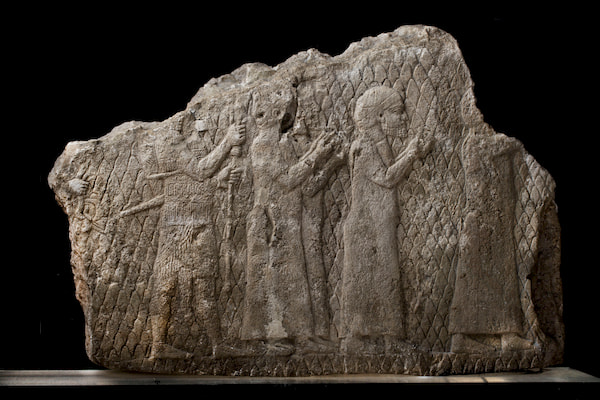
Private Collection, London
Assyrian Relief from Sennacherib's castle, showing Jews of Lachish taken into captivity.
2 Kings 18:9-12 relates to the beginning of the twenty-nine-year reign of King Hezekiah, who reportedly become king in Hoshea’s third year; this coincides with the period of the Assyrian destruction of Samaria which is said to have begun in the fourth year of Hoshea’s reign, lasting until his sixth year. While the Traditional Chronology places these events in 722 BC, this is contradicted by the statement in 2 Kings 18:13 regarding the invasion of Judea led by Sennacherib in the fourteenth year of Hezekiah which according to the Assyrian inscriptions, happened in 701 BC. If so, the events of 701 BC would have taken place in Hezekiah’s twenty-fifth year, not his fourteenth. The narrative in 2 Kings that begins with the conquest of Lachish, an important Judean town, can be confirmed by the Lachish Reliefs set on the walls of Sennacherib's castle, and now kept in the British Museum; additionally, archaeological excavations on the site of Lachish appeared to verify this date for the Assyrian destruction of the city. 2 Kings 18:13-16 continues with another, unrelated, story of the siege of Jerusalem by the Assyrian army. Among Assyrian clay documents there are three hexagonal prisms that are inscribed with the same text recording Sennacherib’s military campaigns, the so-called Sennacherib's Annals. They all contain similar accounts but only one, the Taylor Prism, now in the British Museum, mentions Sennacherib’s interactions with Hezekiah with an account of his successful campaign launched against Jerusalem. According to this, the Judean king was confined to the city "like a bird in a cage", and despite having paid tribute, 200,000 Judeans were sent into exile. Although this story is believed to parallel the Biblical account, it seems likely that the unprovenanced Taylor Prism is one of several mid-19th century fabrications attempting to corroborate the Biblical narrative.
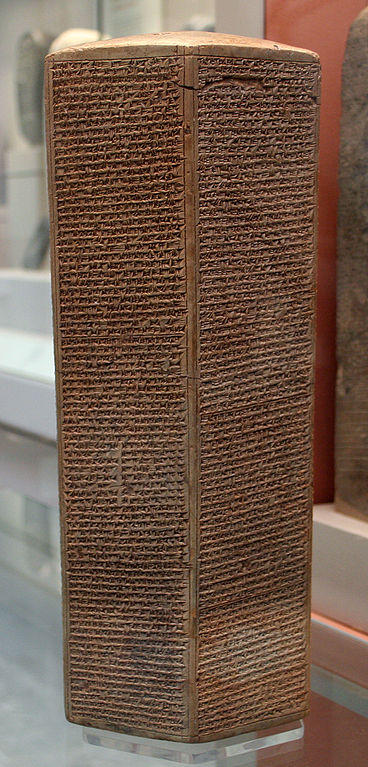
Taylor Prism
2 Kings 18:17-19 gives an account of King Hezekiah’s heroic resistance to the Assyrian invasion of Jerusalem. It reports that King Hezekiah protected Jerusalem with the reputed help of God's Angel who, in one night, managed to kill the entire Assyrian army besieging the city. This account concerning Hezekiah's heroic resistance to the Assyrian invasion might be an attempt by the author of 2 Kings to glorify the period of his reign in ancient history. In his perception, the miraculous slaughter of the enemy by an Angel and the withdrawal of the Assyrian forces could be attributed not only to the broad Judean acceptance of Hezekiah’s authority, but also to his personal commitment to Yahweh. Finally, the "sinful" Samaria was replaced by the "righteous" Judea; Jerusalem was saved, the promise of Isaiah was fulfilled, and Yahweh was recognized as the Only God. Considering that Kings might have had access to Berossus’ Babyloniaca, which praised Sennacherib as the most important Assyrian king, it would not be unreasonable that he chose to glorify the reign of Hezekiah by making him a counterpart of this king too. It is also possible that the author of 2 Kings might have had access to Herodotus’s History II, 141. This described Sennacherib’s unsuccessful military campaign against Egypt and reported that having reached Pelisium on the River Nile, Sennacherib suffered a disaster when field mice invaded the Assyrian camp and gnawed through the quivers, bow strings, and leather shield handles thereby disarming the military force, leading many soldiers to flee or be killed. 2 Kings altered the account given by Herodotus by transposing his story of the failure of the Assyrians in Egypt to their siege of Jerusalem, concluding that the events occurred during Hezekiah's heroic resistance to the Assyrian invasion. In fact, the conquest of Lachish by the Assyrians in 701 BC, and the siege of Jerusalem by the Persians c. 465 BC, are two different events.
While arguing that the Achaemenid period can be equated to the Neo-Assyrian one, Sweeney demonstrated a similarity between the available records of the Assyrian King Sennacherib and those of the Achaemenid King Xerxes, and proposed their identification (35, pp. 127-33). It seems more likely, however, that the confusing chronology of 2 Kings is actually the result of a literary contamination inspired by Berossus and Herodotus, rather than an identification based on fact, and that the reason 2 Kings describes the siege of Jerusalem as happening in the days of Sennacherib is the author’s apparent unfamiliarity with the figure of King Sargon. As the conquest of Samaria happened in 479 BC, and the siege of Jerusalem occurred at the end of Xerxes’s reign shortly before his assassination in 465 BC, it follows that Hezekiah’s reign can be dated to c. 480-50 BC.
The Achaemenid conquest of Judea in the fourteenth year of King Hezekiah’s reign brought an end to the hopes of liberation that the population of Judea clung to. The lengthy period of Achaemenid rule in Judea, lasting from c. 465 BC, explains the complete lack of records covering this entire period. There is no specific evidence in 2 Kings 21 relating to military activities during the reigns of either King Manasseh, the son of King Hezekiah (who is said to have reigned for fifty-five years, the longest reign in the Judean history!), or during the two-year reign of his son, King Amon; both were regarded as "idolatrous kings of Judea". Moreover, no recognizable symbols of power such as seals or bullae have been found relating, undisputedly, to either king. Despite this apparent dearth of information, there is a possibility that Judea continued to exist during this period as a semi-independent principality under the Persian protectorate. It would have been ruled from Jerusalem by a local dynasty who were regarded as being direct descendants of King David.
According to 2 Kings, during the final period of its existence the Kingdom of Judea was situated between the two super-powers of Egypt and Assyria. In the New Chronology, the "Assyrian" kings are identified with the Achaemenids, and the "Egyptians" with the rulers of the Thirtieth Dynasty. During the thirty-one year reign of King Josiah, Judea made another appeal for its liberation; this probably coincided with the formal declaration of independence from the Achaemenids announced by Pharaoh Nectanebo I (379/8-361 BC) who had survived the attack by King Artaxerxes II in 373 BC. Taking advantage of the situation, King Josiah conquered a large part of Syro-Palestine, but the situation of peaceful co-existence between the Egyptians and the Judeans dramatically deteriorated in a later period. King Josiah challenged Pharaoh Necho’s authority and when Necho "went up to [the] Euphrates to fight [the] Assyrian king", he was killed in the Battle of Megiddo (2 Kings 23:29-30). The far-reaching Egyptian military campaign mentioned in 2 Kings can be compared to the events following the death of Nectanebo I; his son, Teos, prepared an offensive against Persia that took place at the end of his brief reign, in 360 BC, when the Egyptians advanced as far as the upper streams of the Euphrates (23). Diodorus XV. 92.3-4 relates that while Teos acted in Syria, his nephew, the future Pharaoh Nectanebo II (360-40 BC) was besieging Phoenician towns; this campaign ended when Nectanebo II decided to declare himself king. The Biblical name Necho appears to be a shortened version of the name of Nectanebo II, which means that Josiah was killed by Pharaoh Nectanebo II in 360 BC. The death of Josiah brought an end to the political independence of Judea.
7. Who was Nebuchadnezzar and when was the Babylonian Exile?
The Biblical figure of King Nebuchadnezzar is not only associated with the demise of the Kingdom of Judea and the destruction of the Temple in Jerusalem but is also regarded as being responsible for the exile of the Jewish nation to Babylon. Scholars generally agree on identifying him with the ancient great king of the Neo-Babylonian Empire, Nebuchadnezzar II. However, an early 6th century BC date (around 587/6 BC) for the final destruction of Judea seems to be contradicted by available archaeological data. Archaeologists who have researched Judean settlements have found no traces of destruction in the layers dating from this period. In sharp contrast to the Biblical narrative claiming this was a time when the "land of Judah was desolated", it would appear that, on the contrary, this period saw the active expansion of different settlements located around Jerusalem. There is, however, evidence to suggest that in the middle of the 4thcentury BC not only was there mass destruction of the cities but also a significant decline in the economic situation in Judea; this was arguably caused by the mass exile of the overwhelming majority of its urban population (2). Archaeological research indicates that during the early Hellenistic period, from the mid-4th century BC and until the 370s BC, the territory of Judea was largely uninhabited, but during the later period a significant growth in the population of the country heralded a period of increased economic prosperity and a remarkable renewal of cultural and political life in Judea.
The primary sources for information concerning the final days of the Judean Kingdom are the two Biblical books: Jeremiah and 2 Kings. They record two Babylonian attacks on Judea and relate that Nebuchadnezzar replaced King Jehoiakim, the son of Josiah who was appointed king by Necho, with his son, King Jehoiachin. After reigning for only three months, the latter was sent into exile along with ten thousand skilled workers and was, in turn, replaced by his uncle, Zedekiah, whose reign lasted for eleven years. The Prophet Jeremiah was active during this period and, despite the continuing commitment of the Judean kings to Necho, he repeatedly prophesied the inevitable submission of Judea to Babylon; this led to his imprisonment. Although Jeremiah’s tendentious account is probably the more authentic one, a stylistic analysis of the Book of Jeremiah shows that it was composed by the same Deuteronomist who authored Kings (32). To confirm the positive identification of the figure of King Nebuchadnezzar, known data relating to his military activities – as recorded in accounts found in the Biblical texts – must be compared to information from external sources regarding the activities of a king who was identified by this name.
At this point we might ask if there is any additional information available in the sources that can support the Biblical story of King Nebuchadnezzar's conquest of Judea, the destruction of the Temple and the exile of the Jews. Traditionally the story of the capture of Jerusalem by the Babylonians is thought to have been independently confirmed by evidence in the cuneiform Babylonian chronicle ABC 5 that describes an attack launched by King Nebuchadnezzar II on the "Land of Hatti", during his seventh year. Interestingly, this Babylonian chronicle relates to the capture of the local king by Nebuchadnezzar and the appointment of a new king of his choice but does not report the story of the exile of the Jews. Moreover, it is not at all clear if the term "Land of Hatti" relates to the land of Judea, as this term often refers to the region of the Hattian people living in central Anatolia. Besides, the date provided by the Babylonian chronicle contradicts the statement in 2 Kings 24:12 that both the first occupation of Jerusalem and the first exile occurred in the eighth year of Nebuchadnezzar. The story in 2 Kings 24 continues in 2 Kings 25:1-7 with another siege of Jerusalem which started in the seventeenth year of Nebuchadnezzar. The second mass exile of the Jews happened soon after the fall of Jerusalem following a Babylonian siege that lasted for a period of two years, from the ninth until the eleventh year of King Zedekiah (Jeremiah 52:11; 2 Kings 24:18). 2 Kings 25:8 also relates that the Temple of Jerusalem was finally burned by General Nebuzaradan in the nineteenth year of Nebuchadnezzar’s reign. However, none of these events, which were traditionally thought to have been dated in 597-86 BC, were referred to in any Babylonian chronicles.
I believe that the events described in 2 Kings relate to a much later time, and, therefore, the figure of the Biblical King Nebuchadnezzar must be identified with the Achaemenid King Artaxerxes III Ochus (358-38 BC). The first invasion of Judea would have to be coincident with Artaxerxes III’s unsuccessful invasion of Egypt c. 350 BC while the actual events that finally brought an end to the existence of the Judean Kingdom relate to the period of 343-1 BC. The two-year siege of Jerusalem that occurred at the end of Zedekiah’s rule would correspond to the period of the successful Achaemenid offensive, led by Artaxerxes III, against the Phoenician cities, in 343-1 BC, and to his successful campaign in Egypt against Nectanebo II, which took place in 341-0 BC. Additional information about Artaxerxes III’s military campaigns are revealed in the prophesy of Ezekiel 26-28 that relates to the Babylonian conquest of Tyre and the invasion of Egypt. This suggests that the second mass exile of the Judean population occurred in 340 BC, and the destruction of the Temple would have occurred in 339 BC.
In addition to the Biblical chroniclers, these events were reflected in the Book of Judith, an early Hellenistic book that became an integral part of the Septuagint but is considered Apocrypha by the Jews (28). It portrays Nebuchadnezzar, the "King of Assyria", as a cruel conqueror of Judea and recounts the story of the resistance of the Jewish people, led by the "High Priest Joakim", against an invasion in the twelfth year of Nebuchadnezzar; this attack was commanded by Holofernes, the "Assyrian" general who was beheaded by a brave Jewish woman, Judith. The figure of Holofernes has been identified as Orophernes, the brother of the Cappadocian ruler Ariarathes, one of the satraps of Artaxerxes III. Another historical figure known from the Book of Judith is Bagoas who discovered the dead body of Holofernes; he was a eunuch of Artaxerxes III, who before playing a role in the king's assassination, had served as a general in his campaigns. If the events recounted in Judith date to the time of Artaxerxes III, this can prove that the Bible identifies Artaxerxes III as "Nebuchadnezzar", rather than identifying him as the Babylonian king Nebuchadnezzar II (35, p. 151-5). The use of the name "Nebuchadnezzar" for Artaxerxes III, the conqueror of Judea, was not accidental as this king played an important role in the Babylonian chronicles and had occupied a special position in the history of Babylon. The Babylonian cuneiform inscriptions claimed that Artaxerxes III rebuilt the city and made it his new capital (6, p. 104-5); this is, perhaps, why he would have been referred to in 2 Kings as the "King of Babylon" instead of being described, like other Achaemenid kings, as an "Assyrian".
The rebuilding of Babylon by Artaxerxes III could also explain the transfer of the thousands of Jewish artisans to Babylon since a qualified labour force would have been needed in order to execute the construction work. The Babylonian cuneiform chronicle ABC 9 reports on many prisoners taken by Artaxerxes III from the Phoenician coast to Babylon and Susa. As evidenced by many Greek and Latin authors (cf. the Byzantine author Syncellus L486.10ff.D, citing a text by Eusebius), the Jewish people were exiled twice by Artaxerxes III – to Babylon and to Hyrcania, an Achaemenid province located on the south-eastern shores of the Caspian Sea. Unlike Syncellus, who mentioned both exiles – one to Babylon and the other to Hyrcania – the Roman historian Orosius,was only familiar with the second, Hyrcanian captivity instigated by Artaxerxes III in 340 BC. Although Josephus (Ag. Ap., I, 22) retained a citation from Hecateus of Abdera, a Greek author from the late 4th century BC who related that "the Persians carried away many thousands of Jews to Babylon", he never realised that this provided crucial evidence for Persian responsibility for the exile.
8. When did Zerubbabel arrive in Jerusalem?
Ezra 1:1-11 provides further insight into the Persian perspective of ancient Jewish history and reveals the circumstances behind the return of the Jews to their land; it opens with the proclamation of the liberation of the Jews that occurred in the first year of Cyrus the Great. This information was later corroborated by a story recorded in Ezra 6:2-11 describing how, during the reign of King Darius, after Cyrus’ decree was apparently "discovered" in the archives of Ecbatana in Media, the Jews were permitted to return to their land and to rebuild their Temple. Traditionally, this decree is thought to be similar to the one recorded on the Cyrus Cylinder, now in the British Museum, which is regarded as the first "Declaration of Human Rights". The historicity of this decree, as it relates to the Jews, was questioned by Grabbe who pointed out that the Cylinder does not contain any specific reference to the Jews and that, actually, this decree could be interpreted as a general policy allowing various groups of deportees to return to their places of origin (18). The story recounted in Ezra concerning a decree that was, apparently, "found" should not be dismissed as a fantasy of its author. The story could be based on actual events that occurred in the time of King Darius when a fabricated document that was allegedly preserved from the time of Cyrus the Great, had, in fact, been produced by the Jews in Media. Such a document, when presented to the king, would have allowed the Jews to appeal for their freedom invoking the ancient king, Cyrus the Great, the founder of the Achaemenid dynasty, as the supreme authority of their fate.
Following on from the story of Cyrus’s decree, Ezra 2:1-2 also relates that the first large group of Jewish exiles was led by Zerubbabel, who was sent to Judea by the Persian King Darius. With the help of the Priest Joshua, he began construction of the Temple’s altar that lasted from the second until the sixth year of King Darius’s reign (Ezra 3:1-13; 4:1-24). The texts of the Prophets, Haggai 1:1 and Zechariah 1:1, appeared to confirm this chronology; they describe that in the second year of King Darius’s reign, the Prophets Haggai and Zechariah, appealed to Zerubbabel and Joshua concerning the building of the Second Temple. In order to precisely date the commencement of the process to rebuild the Temple, as well as to establish the circumstances that led to the Jews’ return from exile, it is necessary to determine the dates of King Darius's reign. One possibility to be seriously considered is to identify King Darius as the last Achaemenid king, Darius III (336-30 BC). In this case, the return of the first group of Jews would have occurred in 335 BC, and the process of rebuilding the sacrificial altar could, therefore, be dated to c. 335-30 BC.
The possible identification of the figure of King Darius in Ezra with the mysterious figure of King Darius the Mede in Daniel raises questions about the actual historical circumstances surrounding the early release of the Jews from their Babylonian captivity, prophesied by Daniel. Traditionally, it was assumed that Prophet Daniel was a child when he was taken into exile by Nebuchadnezzar II, and that he lived in Babylon in the 6th century BC until his death at the very end of the Babylonian Empire, c. 539 BC. In the course of research it has become clear, however, that the entire story of Daniel was set in the Hellenistic period since the main body of Daniel was composed during the 4th century BC although there were, clearly, some later additions as his prophecies related to the events of a future period. It has, therefore, been proposed that there were two figures called Daniel – one living in the 6th century BC and the other living in the 4th century BC – and that they were combined by a later, 2nd century BC editor of Daniel. What if, however, all the chapters relating to the adventures of Daniel and his role in the life of the Babylonian captives are from the 4th century BC? Is there a possibility that Daniel was a 4th-century BC historical figure?
The story of the Book of Daniel contains an account of an episode, when Daniel, while attending a banquet given by King Belshazzar, the son of Nebuchadnezzar, was invited to read a strange inscription that appeared on the wall. Based on his interpretation of it, Daniel 5:28 prophesied the imminent overthrow of King Belshazzar and the conquest of his kingdom following an invasion by Medes and Persians. Daniel 6:30-31 also reports that the prophecy was, indeed, fulfilled: King Belshazzar was killed, and Babylon was conquered by King Darius the Mede. This king held Daniel in high esteem and rewarded him with important positions, including that of the Chief Governor of Babylon, which led to a conspiracy against him. Following Daniel’s miraculous escape from the lion's den, King Darius, filled with awe at what had happened, issued a decree that everyone should worship "The God of Daniel" (Daniel 6:26). If the historicity of the events described in the Book of Daniel can be proven, it may be argued that the Jewish-oriented policies of Darius the Mede might have been due to the influence that Daniel exerted over him. When previous generations of scholars were attempting to set the story of Daniel into the historical reality of the 6th century BC, they noticed that, according to all the available historical sources, the Babylonian Empire was conquered in 539 BC by the Achaemenid King Cyrus the Great, and furthermore that the last king of the Neo-Babylonian Empire was named Nabonides, not Belshazzar. These comments raised doubts about the historicity of Belshazzar and Darius.
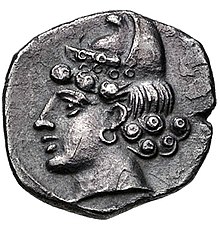
Coin of Artaxerxes V Arses
In my opinion, the historical reality behind the chapters of Daniel telling of the invasion of Babylon by the Median and Persians forces fits better into the turbulent political situation pertaining in Babylon after the death of Arses (338-36 BC) – Artaxerxes IV – the son of Artaxerxes III Ochus, who could have been identified by Daniel as King Belshazzar, the son of King Nebuchadnezzar. It should be noted that Darius the Mede was named the son of Ahasueros in Daniel 9:1, allowing him to be equated with the Persian King Darius III; he was a governor of Media and rose to power following the assassination of Arses by Bagoas, the same general who poisoned Artaxerxes III. The Greek sources agreed that Darius III was not a member of the mainstream Achaemenid dynasty, which is why Alexander the Great was able to justify his military actions against him, believing that he was actually restoring order by removing an imposter from the throne. This suggests that when the Median and Persian forces took control of Babylon in 336 BC, Darius III, who previously ruled Media, was declared the King of Persia, and Daniel was then appointed as the supreme ruler of Babylon. It can be inferred that Darius III took his important decision relating to the fate of the Jews as a result to the influence exerted by Daniel, and that, following the conquest of Babylon by the Persians and Medes forces, the prevailing situation enabled Zerubbabel to leave in the following year. Thus, the information revealed in the Book of Daniel could explain the unexpectedly positive attitude of the new ruler towards his Jewish subjects, as well as the circumstances behind their miraculous escape from captivity.
The pro-Jewish attitude of King Darius is revealed in a letter written in Aramaic from the collection of the Elephantine Papyri found in Lower Egypt, often referred to as the Passover Papyrus (30: B13); this document has been previously dated by scholars to 419 BC. In the letter, dating from the fifth year of Darius, an official named Hananiah informed an officer named Yedaniah about the strict regulations for Passover observance that had been approved by Darius for the Jewish soldiers who were entrusted to protect Persian interests and garrisoned in Elephantine. The name of Hananiah pehah also appears among Samaritan Wadi Daliye Papyri dated after the Macedonian invasion (10), as well as on a bulla found in the post-exile archive that presents him as an officer in charge of fiscal matters (1). The fact that a Persian king took an interest in Jewish religious matters indicates the special feelings this king had towards his Jewish subjects. Thus, the reference to Darius III in the Passover Papyrus, written in 331 BC, points to his ultimate authority over Lower Egypt and can be regarded as additional confirmation that this region remained under Persian rule.
Proof of the power exerted by the Persians over Judea is revealed in another document of the Elephantine Papyri, referred to as the Petition to Bagoas (Bagavahya), Governor of Judea, and dated from the seventeenth year of King Darius (30: B19; B20). The Petition was written to the Persian governor and requested help in rebuilding the Temple in Elephantine that had been demolished by the Egyptians; it was composed by Jewish soldiers led by Yedaniah, who were guarding Persian interests in the Lower Egypt region. The Petition related that the High Priest of Jerusalem, Johanan, had denied a previous request, and it also mentioned that another petition had previously being made to Delaiah and Shelemiah, the sons of Sanballat. This name appears to be identical to that of Sanballat, the Samaritan governor who according to Josephus XI:7,2 was appointed by Darius III. It confirms that, long after Darius III's death, the Jewish population of Lower Egypt continued to count the dates according to his reign, while appealing to Bagoas, the governor of Judea, as a supreme authority.
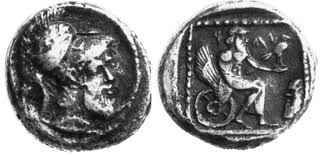
The British Museum
Bagoas coin
Josephus XII:7,1 recounted a story of how Bagoses, a Persian strategos of Artaxerxes III, interfered in the appointment of the Jewish High Priest by supporting Joshua, a candidate who was ultimately killed by his brother Johanan in a fight for the office. To show his anger at Joshua’s murder, Bagoses desecrated the Temple by walking into its inner court and persecuted the Jews by imposing heavy taxes. However, it seems that he allowed Johanan to continue serving as the High Priest. There is every reason to believe that the source of Josephus’s story related to the death of Joshua, Zerubbabel’s companion, and dated to the time of King Darius III. General Bagoses is, in fact, not only identical to the eunuch of Artaxerxes III but also to Bagoas (Bagavahya), who was regarded as the primary authority in Judea and was the actual addressee of the Elephantine Petition. Bagoses/Bagoas, who was one of the heroes in the Book of Judith, participated in the Achaemenid conquest of Judea in 341 BC and played a decisive role in the assassinations of Artaxerxes III and his son Arses in 338 BC and 336 BC, respectively. He was also involved in the appointment of King Darius III and was regarded as the chief supervisor of the region of Judea on behalf of King Darius III. Bagoses’s portrait appears on a unique silver drachm from the British Museum collection, where he is shown wearing a helmet on the obverse, with the image of Yahweh enthroned and sitting on a winged wheel, on the reverse (33). This unusual and unique anthropomorphic representation of the Jewish God, Yahweh, next to the figure of a Persian general confirms the enormous respect the Persian authorities felt for the Jewish religion during the days of Darius III.
9. When did Nehemiah arrive in Jerusalem?
The Biblical narrative suggest that the fate of the Jewish nation started to improve when the Persian King Artaxerxes sent his "cupbearer", Nehemiah, a Jew from Susa, to govern Judea; he was accompanied on this mission by a group of local Jews. His deeds are described in Nehemiah'sMemoirs, which were later incorporated into the Book of Nehemiah; the Memoirs are written in the first person and are believed to have been composed by Nehemiah himself, thus providing an authentic and reliable source of information. The thoughtful textual analysis offered by Jacob Wright supports the idea of the "process" of a gradual evolvement, in three major redactions, of the Book of Nehemiah that all took place during the Hellenistic period (39). In his opinion, it was developed from an original text covering the encounters between Nehemiah and Artaxerxes, a brief report on the wall-building, and another polemic text, written by Nehemiah against his enemies. Nehemiah relates that he served under Artaxerxes from his twentieth year (2:1; 13:6), after which he was recalled to the king's court although he did return to Jerusalem in his thirty-second year. Nehemiah claimed that, upon his initial arrival, he found Jerusalem in ruins and lacking any form of administration; therefore, he decided that his primary objective would be to rebuild the destroyed walls of the city. He recorded that he was initially supported in the execution of this project by the High Priest Elyashiv (3:1). This project did not meet with unanimous approval and there are frequent references to Nehemiah’s influential adversaries who strongly objected to it. These people were all local leaders: Geshem, the Arab; Sanballat from Horon; and Tobiah of Ammon. The key questions to be answered are: firstly, when did these people live; and secondly, which Persian king sent Nehemiah on his mission?
Traditionally, scholars assumed that the events recorded in Ezra-Nehemiah must be dated to the Achaemenid period. In view of the weak archaeological data attesting to Jerusalem as an urban centre during the Achaemenid period, Israel Finkelstein doubted that the small population of Jerusalem, estimated to be around five hundred people, could have produced anything of literary significance. Accordingly, he proposed a radical re-evaluation of the research by suggesting the Hellenistic period as the setting for the historical events and figures that are mentioned in Ezra-Nehemiah. In support of a Hellenistic date for these texts, he cites a number of examples: for instance, some of the Judean cities that the builders of Nehemiah's wall came from did not exist in the Achaemenid period and were only built in Hellenistic times; moreover, there is no evidence of city walls built in Jerusalem between the Iron Age and the Hellenistic period (13, p. 3-27; 71-82; 102-6).
While Finkelstein maintains that the historical realities of Judea as they are described in Nehemiah could only have existed in the Hellenistic period, and preferred 2nd century BC over the 3rd century BC as a historical setting, he did not, however, address the question of the actual dates of Nehemiah’s mission. Dating Nehemiah’s activities to the 5th century BC and his book to the 2nd century BC prevents it from being regarded as a reliable record of historical events. However, what if Nehemiah – as well as his adversaries – were real historical figures of the Hellenistic period whose deeds were described in the Memoirs, while the Book of Nehemiah was reedited in a later period?
As Finkelstein pointed out that the names of Nehemiah’s adversaries only appeared in original documents from the Hellenistic period, we must look for the correct timeframe when all these figures could have acted together. The figure of Sanballat from Horon, mentioned in Nehemiah, is identical to the governor Sanballat of Samaria, who was described by Josephus XI:7, 2 as the first governor of Samaria serving on behalf of King Darius III. Different coins bearing this name have been discovered (26, pp. 26-27), and his name has also been found on a bulla of his son, Yeshayahu, that was excavated alongside the Wadi Daliye Papyri, a collection of Samaritan legal documents, written in Aramaic, which were dated by the scholars to the mid-4th century BC (10). Interestingly, some of the Papyri were dated according to the reign of King Artaxerxes; in others, the presence of Greek soldiers in Samaria is mentioned. Since the name of the Persian king who reigned during the Macedonian conquest was Darius, not Artaxerxes, and the Greeks were known to have conquered Samaria first under Ptolemy I in 312 BC, it can be suggested that these Papyri belonged to the time of fratarakā Artaxerxes and must therefore be dated between 321 - 12 BC.
Amongst Nehemiah's adversaries, the figure of Tobiah, the Jewish ruler of Ammon, is the most puzzling. Nehemiah 4:1-8 stated that Tobiah was initially very close to Sanballat and supported him in his resistance to Nehemiah’s project of rebuilding the walls around the city of Jerusalem. Nehemiah 13:7-9 also relates that, upon Nehemiah’s return to Jerusalem after visiting King Artaxerxes, he found that Elyashiv had become friendly with Tobiah and had given him a separate chamber in the Temple in which to keep his precious possessions. This angered Nehemiah who reacted by throwing out his belongings and then ordering the chamber to be cleansed. Using information from an early Hellenistic source, the Tobiades Roman, Josephus XII:4 recounted the story of the rise to power of the aristocratic family of the Tobiades and stated that Tobias (a Greek version of the name Tobiah) was the founder of the Jewish dynasty of the rulers of Amman. The Tobiades Roman includes an account of Joseph, the son of Tobias, who had a successful career under the Ptolemies; he rose to prominence after the High Priest Onias had stubbornly refused to pay the taxes demanded by Ptolemy, and Joseph was appointed to be the tax collector for the Syro-Palestine region. Josephus dates these events to the time of Ptolemy V Epiphanes, after the region was returned to him by Antiochus III as part of the dowry for the marriage of his daughter Cleopatra I to Ptolemy V in 193 BC. According to Grabbe, although the general dating of the events in Josephus does not make sense, Josephus’s mistakes in placing his sources into an overall framework do not detract from the fact that the whole story is original (19, p. 136-139). What, however, was the historical setting for the story of the rise to power of the Tobiades dynasty?
It seems that the most probable timeframe is that of Ptolemy II Philadelphus (283-246 BC). This can be confirmed by a collection of documents found in the archive of Zenon Papyri discovered in Philadelphia, in Egypt. Zenon was an agent of Apollonius, the finance minister of Ptolemy II, and in 259 BC he was sent to Syro-Palestine to establish trading contacts. Upon his return, he continued to maintain a connection with his partners there and communicated several times with Apollonius on different matters. A number of documents connected with Zenon’s tour found their way into his archives, including a bill of sale for a slave from year 27 of Ptolemy II (256 BC) that briefly mentioned Tobias, and a personal letter of Tobias from year 29 of Ptolemy II (254 BC) that records his gift of slaves to Apollonius. In the former document Tobias is noted as overseeing the birta, a fortress located in the Ammonite region. This information may confirm that Tobias, who had occupied a prominent position under Persians, retained his power when the region came under Ptolemaic rule. In addition, another letter from the Zenon archive, dated from year 27 of Ptolemy II (256 BC), mentions a Jewish leader named Jeddous (Jaddua). The same person, who served as a High Priest, is also known to Nehemiah 12:11 as a younger member of the family of Elyashiv.
Josephus XII: 4, 11 also recounts that later, during the reign of Seleucus IV (187-175 BC), the youngest son of Joseph, named Hyrcanus, proclaimed himself an independent ruler of an area surrounding the fortress of Tyros in Transjordan; he controlled this region for a period of seven years, fighting local tribes of Arabic origin, before finally committing suicide. Hyrcanus's splendid fortress in Tyros, described in detail by Josephus, has been identified as the Hellenistic castle of Qasr al-Abd, in Araq el-Emir, whose ruins stand in the valley of Wadi as-Seer, to the west of Amman.
As the Memoirs of Nehemiah reported that Nehemiah was sent on his mission by the Persian King Artaxerxes, to clarify the timeframe for Nehemiah, it is important to establish his identity and the dates of his reign. Traditionally, it is claimed that Judea remained under Persian rule until the Macedonian conquest of the Achaemenid Empire in 332 BC, and that in the Hellenistic period, following the fight of the Diadochi, it lay between the Ptolemaic and Seleucid Empires; the Ptolemaic rule is generally accepted as having lasted from 302/1 BC until Antiochus III’ conquest in 200 BC following which control of Judea passed to the Seleucids. Historians generally believe that the Achaemenid Kingdom ceased to exist as a strong political entity after the Macedonian conquest and, therefore, rejected the possibility that Persian rule in Judea could have continued after 332 BC. However, in the light of recent research on the history of the Kingdom of Persis, this concept now needs to be reviewed. The concept of the political revival of Persia during the early Hellenistic period promoted by scholars is mainly supported by numismatic evidence (6; 7; 8; 16; 28).
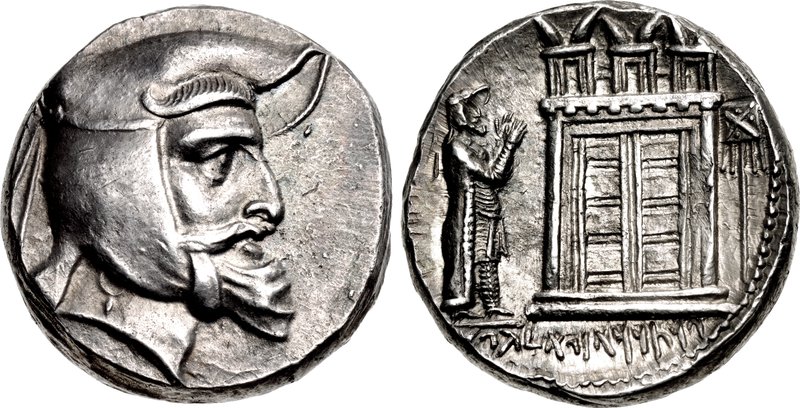
Classical Numismatic Group, Inc. http://www.cngcoins.com [CC BY-SA 3.0], via Wikimedia Commons
Coin of Artaxerxes frataraka
The relative chronology of the fratarakā kings of Persis is disputable and, due to the fragmentary nature of the written sources, research is primarily based upon the evidence of the locally-minted silver coins on which the fratarakā rulers expressed their close ties to the Achaemenid kings. It was initially proposed that this Hellenistic dynasty emerged in Fars as Seleucid representatives, and that the Kingdom of Persis was released from Seleucid rule around 275 BC. Furthermore, it was previously thought that fratarakā Bagadad was the first independent ruler of Persis and that he initially overstruck Seleucid coins before later minting coins with his own name, apparently written in Aramaic script. He is depicted wearing a satrap headdress and Hellenistic diadem and either making devotions to a fire altar, or enthroned (21). The reign of Bagadad was believed to be followed by other fratarakā rulers, named Vahbarz, Vadfradad, and Artaxerxes. More recently, however, this sequence of fratarakā was challenged, and it was suggested that the first independent ruler of the Hellenistic Kingdom of Persis, following Macedonian invasion, was named Artaxerxes (16; 28). The issue of the silver drachm coins of the fratarakā, Artxashastra (Artaxerxes), found in a hoard in 1986 next to coins of Seleucus I (312-281 BC) and published by Brian Kritt in 1997, record a crucial moment in the Hellenistic Kingdom of Persis securing its independence (7). The obverse of these coins depicts a bust wearing a satrap hat, and on the reverse, he is shown standing with raised hands in front of a ritual square structure, which is often identified by scholars as the fire altar of the Zoroastrian Temple.
The important question that remains unanswered is: how should the beginning of fratarakā Artaxerxes’ reign be calculated? In my opinion, all the Elephantine Papyri that belong to the period of King Artaxerxes’ reign, and thought to date to the 5th century BC, actually, can be related to fratarakā Artaxerxes. The group of Papyri dated from the 6th until the 19th year of Artaxerxes’ reign belonged to Mahseiah, the son of Yedaniah, who served under Darius (B25-B29); this suggests that Artaxerxes reigned after Darius, not vice versa. In addition, the first mention of the term fratarakā found in the Elephantine Papyri dates from the period of Artaxerxes; no such title was recorded in the Achaemenid period. The latest documents of the Elephantine Papyri that were issued during the time of King Artaxerxes are dated to the thirty-eighth year of his reign (B10; B37; B39), indicating that the Persians maintained control of Lower Egypt after the Macedonian invasion. On the other hand, the earliest Papyri, which date from the time of Ptolemy I (304-282 BC), survived from his 40th year (D3), meaning that this region passed to Ptolemaic control in 284 BC. These dates suggest that the reign of fratarakā Artaxerxes started in 322 BC, soon after the death of Alexander the Great in 323 BC. It, therefore, follows that Nehemiah’s appointment in the 20th year of King Artaxerxes occurred in 302 BC. The consequences of Ptolemy I’s disastrous attack on Jerusalem that occurred in the same year would explain why, when he arrived in Jerusalem, Nehemiah found a scene of destruction and a city without administration.
It can be suggested that following Seleucid conquest of Babylon in 312 BC, the Persians and the Greeks managed to co-exist peacefully. However, comparative analysis of the sequence of hoards preserved with the victorious coins of King Seleucus I minted in Susa in 301 BC, with the stratigraphic observations on the destruction level in Pasargadae that was burned to the ground c. 300 BC, suggests that, when fratarakā Artaxerxes challenged Seleucus I in 302/1 BC, this led to a large-scale confrontation. Considering that he first rose to power in 322 BC, it can be inferred that it was twenty years later that fratarakā Artaxerxes not only exerted his authority over the lands of Fars but also attempted to reclaim previously held Achaemenid lands. Accepting that the Persian King Artaxerxes V referred to by Nehemiah was none other than fratarakā Artaxerxes, and that Nehemiah ruled as pehah - Governor of Judea - from his 20th until his 32nd year, the general timeframe of Nehemiah’s rule can be established within the period of 302 - 290 BC, although it seems possible that upon his return to Jerusalem following his visit to the King, he might he might have continued being in charge during the later period, until around 275 BC.
It is significant that Nehemiah’s Memoirs begin with the period when he served in the king’s castle in Susa. The excavations of that city reveal, at the southern point of the mound of the Royal Town, the Donjon, a monumental government building from the Hellenistic period that could have served as the king’s castle (38). Before the attack of Seleucus I in 301 BC, the capital of the kings of Persis was in Susa, although it later moved to Persepolis, the old ceremonial seat of the Achaemenid kings. Apparently, the city of Susa was also the capital of Ahasueros who appears as a central figure in the events of Purim described in the Book of Esther. As Ahasueros is the Aramaic version of name Artaxerxes, this identifies the fratarakā Artaxerxes as the hero of the Purim story. While scholars rejected the historicity of this book, based on Hellenistic details in the depictions of the king’s court and, pointing to its unfamiliarity prior to the 3rd century BC, they have assumed a Hellenistic date of the book that seems to describe events that allegedly took place in the Achaemenid period. In my opinion, it appears to, actually, be an authentic and contemporary – although very biased – description of events that took place in the early Hellenistic period.
It is not an accident that Nehemiah was portrayed, not as a figure from the remote past, but as the predecessor of Judah the Maccabee in an event recounted in a letter sent by Jews in Jerusalem to their coreligionists in Alexandria in 188 S. E. (124 BC) and preserved in 2 Macc. 1:20-36 (37). This letter described how, during the purification of the sacrificial altar in Jerusalem at the Holiday of Sukkot, the altar was miraculously restored by Nehemiah, who used a substance called nephthar ("oil") to kindle the sacred fire hidden by priests of the Temple before they went into exile. Theodor Bergren has argued that this narrative seeks to demonstrate that there was continuity between the First and the Second Temples cults, and that there was a historical precedent for Judah the Maccabee’s purification of the sanctuary (2), nevertheless certain details of this narrative, which remained unknown to Nehemiah, suggest that is should be regarded as an authentic account. During the purification of the altar, Nehemiah was aided by the Priest Jonathan, who was identified by Nehemiah 12:11 as the son of Joiada, and the grandson of Elyashiv. Interestingly, although this narrative only focuses on the restoration of the altar, not on the Temple itself, this information can also be compared with 2 Macc. 1:18, where Nehemiah was credited with constructing the walls of Jerusalem as well as with the building of the Temple. In addition, 2 Macc. 2:13-15 also credited Nehemiah with gathering the Hebrew books; taken together, these provide us with additional arguments in favour of Nehemiah’s exclusive role in the formation of the Biblical canon.
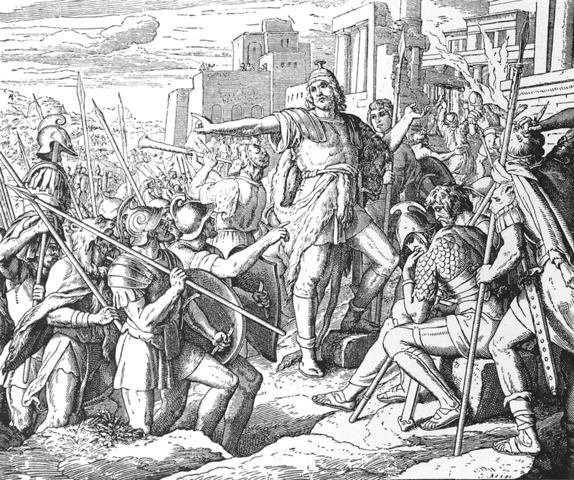
From: Die Bibel in Bildern
Judah the Maccabee commanding rededication of the Temple
10. When was the Hebrew Bible composed?
Resolving the question of the origin, authorship, and dating of the Five Books of the Torah, the most important books of the Hebrew Bible, is one of the key issues for establishing the historical value of the Bible. Recently, the traditional view regarding the dating of the Pentateuch as well as circumstances of its composition, was challenged by Russell Gmirkin. In his opinion, the main redaction of the Hebrew Torah was issued shortly before its Greek translation, the Septuagint, which was composed by seventy Jewish sages in Alexandria under Ptolemy II c. 270 BC; this indicates that the editors of the Hebrew Torah could indeed have utilized the books of the early Hellenistic historians – Manetho, who wrote in Ptolemaic Egypt, and Berossus, who was active in Seleucid Babylon – as evidenced by the literary dependence of the Torah on their texts, issued around 280-78 BC (16). Later, Gmirkin also argued that the laws of the Torah were influenced by the ideas of Plato’s Laws housed in the Great Library of Alexandria(16a).
In my opinion, the first four Books of the Torah were issued under King Josiah. 2 Kings 22:8 claims that in his eighteenth year, while Josiah was supervising the renovation of the Temple in Jerusalem, a "lost copy" of the "Books of the Torah" was suddenly discovered by the High Priest Hilkiah. Considering that King Josiah’s reign, according to the New Chronology, can be dated from 391-60 BC, the first issue of the Torah by Hilkiah must be dated to c. 373 BC; this roughly corresponds to the spread of the influence of Platonic Academy that had been established in Athens in 387 BC. Although this "find" is often considered by scholars to be related to the Book of Deuteronomy, the Fifth Book of the Torah, it seems more probable that Hilkiah was responsible for the primary edition of the first Four Books of the Torah, while the Deuteronomist dealt with situation pertaining after the Babylonian exile. The Deuteronomist sets the words of Moses in the timeframe prior to the Israelites’ entrance into the Land of Israel, employing contextual similarity to the experience of the Jews’ returning from exile. It promised that the Jews would only be guaranteed the entire Land of Israel if they submitted fully to their Covenant with God. By contrast, the first Four Books of the Torah focus on issues relating to the Exodus from Egypt. The idea of "separation" from Egypt would only become relevant in the time of Josiah, when the first declaration of independence from Egyptian rule was issued. The first celebration of Passover under Josiah (2 Kings 23:21) appears to be a celebration of the liberation from Egyptian rule. This date fits in better with Gmirkin’s analysis showing that the figure of Moses was based on the Egyptian king-magician Nectanebo II (16, ch. 9).
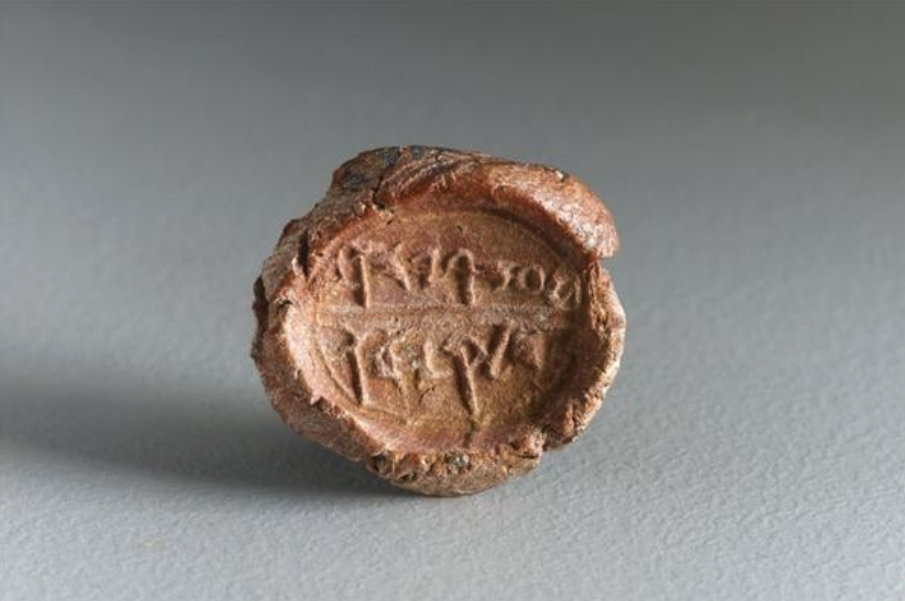
Israel Antiquities Authority | Koren Miki
Bulla of Hanan, son of Hilkiah
An important question to be answered concerns the dating of the literary activities of the author of the Biblical books of Deuteronomistic history (32), including Joshua, Judges, Samuel and Kings as well as Jeremiah; these books reflect on the disaster that befell the Jewish nation following the annihilation of their Kingdom, blaming it on the wickedness of the kings and on the lack of adherence to the Laws of the Torah by the people. The last event recorded by both Jeremiah and Kings describes how the Babylonian King Evil-Merodach released King Jehoiachin after thirty-seven years in captivity. Considering that he went into exile c. 349 BC, this means that he was released in 312 BC when Seleucus I took firm control of Babylon and, after being declared as king, had the power to order the release of Jehoiachin. But why would a Greek king of Babylon be identified as Evil-Merodach, the "Son of Marduk"? It has been noted that the famous Borsippa Cylinder, dated to 268 BC and issued by Antiochus I, a son of Seleucus I, refers to the revival of the cult of the great Babylonian god Marduk who was worshipped in the Temple of Nabu in Borsippa (22). Hence, the Biblical name Evil-Merodach was applied to Seleucus I who presented himself as a viceregent of the great Babylonian god Marduk.
A clue to the identity of the early Deuteronomistic historian can be found in Josephus's booklet, Against Apion I, 187-189, where he cited the story of Hecateus of Abdera concerning the respected Jewish Priest, Hezekiah, who willingly emigrated to Egypt after Ptolemy I’s attack on Jerusalem, probably travelling there along with the captives taken by Ptolemy I. Josephus XII:1.1 claimed that when Jerusalem was captured by Ptolemy I by deceit on a Shabbat, it resulted in many captives being taken to Egypt; this would have formed the basis of the large Jewish Diaspora in Egypt. It is debatable whether his attack on Judea occurred in 312/1 BC after his conquest of Gaza, or in 302 BC before his invasion of Syria (3, p. 76-7), since the only source on these events, Agathachides of Cnidus, which was quoted by Josephus, does not provide us with any precise dating. Josephus relates that, after Hezekiah arrived in Egypt, he publicly recounted the ancient history of Judea, thereby positioning himself as the first Jewish historian. This means that the books of the Deuteronomistic history could have been written by Hezekiah upon his arrival in Egypt, although textual analysis suggests that they were re-edited again upon the Jews’ return from exile. These books appear to be an amalgamation of two distinct traditions derived from two different sources, one Egyptian and the other Babylonian. If we accept that the first should be associated with the literary activities of Hezekiah, what would be the identity of the principal post-exilic editor?
In my opinion, this figure must be identified as Ezra the Scribe who is perceived as the legendary creator of the Jewish religion and is also credited with bringing the remaining Jewish exiles with him from Babylon when the decree issued by Artaxerxes, in his seventh year, allowed the Jews to return to their homeland (Ezra 7: 6-28). However, the historicity of the figure of Ezra has been questioned by scholars (9, p. 120-123) since he was ignored by Ben Sira. This implies that Ezra was not yet present in Judea when this book was written, but if this is the case, when did he arrive? If, indeed, Ezra came to Jerusalem in the seventh year of the same king who sent Nehemiah, it would mean that Ezra arrived around 315 BC, before Nehemiah who apparently came in the twentieth year of the same king. There is, however, a chronological problem with this date, as it would place Ezra’s arrival during the Diadochi War; besides, other parts of the text clearly imply that Ezra must have arrived in Jerusalem after Nehemiah since, by the time Ezra initiated his reforms, the Temple was already standing; this corresponds to 2 Maccabees which credits Nehemiah with building the Temple. In addition, Ezra 10:6 reports that at the time of his reforms, Ezra hid in the Temple’s chamber belonging to Johanan, the grandson of Elyashiv, whose lineage is provided in Nehemiah 12:22-23. This suggests that when Nehemiah first assumed charge of Jerusalem and rebuilt the walls, there was not yet a Temple; this was founded later. Ezra is mentioned in Nehemiah 8-9 in a section that relates to a description of an event during the last years of Nehemiah, when the two are brought together in a dramatic scene when the "Law of God" is given to the people.
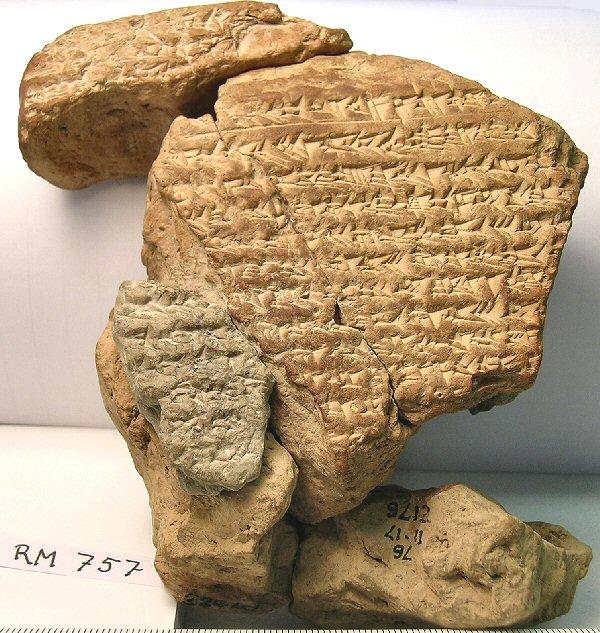
Babylonian cuneiform inscription regarding transfer of population by Antiochus
One solution to the problem of Ezra’s chronology would be to suggest that the original text should have read *forty-seventh year of Artaxerxes and not the seventh year. In this case, the Jews of Babylon would have arrived with Ezra in 275 BC, and Ezra’s reform would have followed Nehemiah’s, but it would also allow them both to have been active towards the very end of Nehemiah’s rule. It seems that the escape of the Jews coincided with the transfer, ordered by Antiochus I, of the Greek inhabitants of Babylon to Seleucia-on-Tigris in 275 BC, a fact that was recorded by Greek sources as well as on the Babylonian cuneiform tablet BCHP5. This enforced exodus resulted in the city being almost entirely depopulated (6, p. 141-2). The general context behind Ezra’s arrival implies that Persian control would have to have been fully restored for the Jews to have left Babylon, something that would have been possible in 275 BC when Antiochus I was occupied in the west fighting in the First Syrian War against Ptolemy II. This means that Ezra was active towards the end of the Persian period.
The New Chronology not only identifies Ezra as the leader of the returnees but also confirms him being the main editor of the Hebrew Bible. Ezra provided the ideological basis for the claims of the Jewish returnees to the Land of Israel, ignoring the role of Mount Gerizim and positioning the Temple Mount in Jerusalem as the unique religious and political centre of the Jewish nation; in this way the superiority of Judea over Samaria was strongly emphasized. As can be seen from Ezra-Nehemiah, the ideological confrontation between the returnees and the Samaritans due to the latest objection to the Temple’s building was one of the most problematic issues; Josephus XII:1 reports on the public disputes between the Judeans and the Samaritan Jews that took place under Ptolemy II, focusing on the question of whose Temple should be regarded as the earliest and the most important.
The proposed date for Ezra’s intellectual activities not only fits more accurately with the idea of Niels Lemche to consider the Hebrew Bible as a Hellenistic book (24), but also ties in with the dating of the Pentateuch provided by Gmirkin (16). From this perspective, I accept Gmirkin’s conclusions on the literary dependence of Genesis 1-11 on Berossus’ Babyloniaca, and the reflection of political divisions into Seleucid and Ptolemaic territories in the 270s BC in the geographical information in the Table of Nations, as well as in the Curse of Canaan; however, I would disagree with his idea that the entire Torah was written in Alexandria. It is not at all certain that Berossus’ book reached its Great Library, and only a person who lived in Babylon in 278 BC would have had a direct access to a copy. In my opinion, the expressive ethno-cultural Babylonian context of the Torah as well as Kings can only be explained by the Babylonian origin of its last editor that better suites the figure of Ezra. Gmirkins idea concerning the literary dependence of the Torah on Manetho’s account of the Exodus story cannot be accepted; quite the opposite is true. The arrival of the Jews in Ptolemaic Egypt and the popularity, there, of the Exodus story there probably created a great interest among Egyptians; this resulted in Manetho’s polemical version relating to the expulsion of the alien Hyksos tribes from Egypt. It is also worth noting that no Biblical manuscripts have survived from before the 3rd century BC, with the earliest examples found among the Dead Sea Scrolls, indeed, the first reference to the existence of the Biblical writings has commonly been attributed to Hecataeus of Abdera’s, in his Aegyptiaca, dated to around 320-300 BC. Although Gmirkin attempted to challenge the authenticity of this evidence, it seems that Hecataeus could have been familiar with the Four Books of the Torah, which existed prior to the final edition of Pentateuch issued by Ezra.
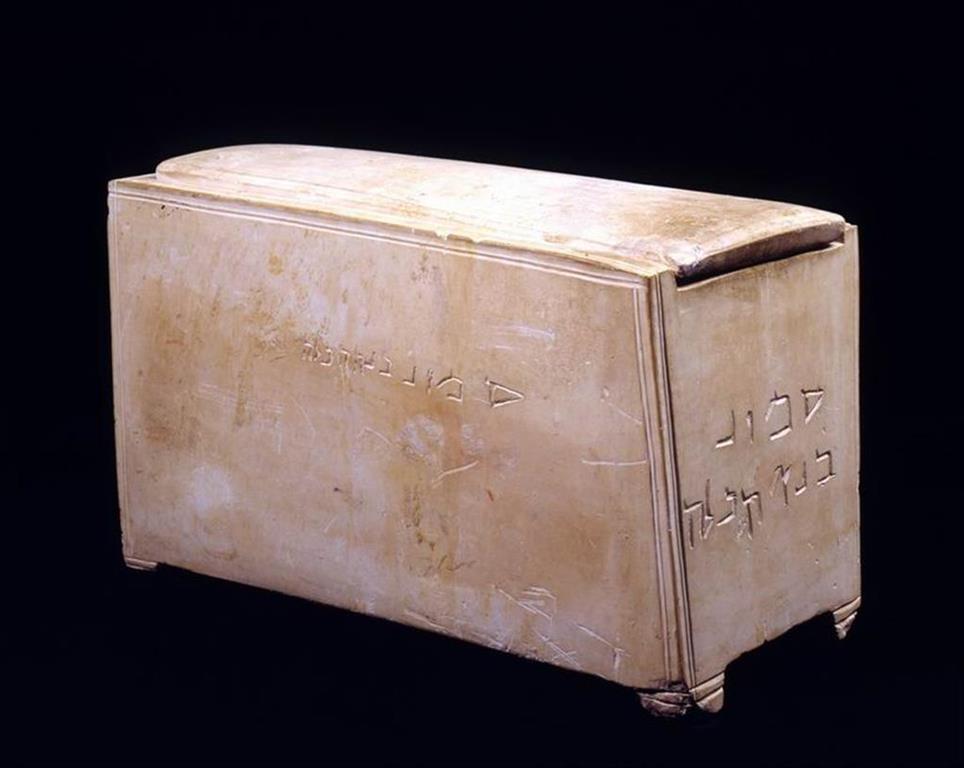
The Israel Museum, Jerusalem
Stone ossuary
One of Ezra’s main tasks was to transliterate the texts of ancient Jewish literature written in the Paleo-Hebrew script, into the square Hebrew script which was accessible to the Babylonian returnees. While the square script obviously had its origins during the period of exile and must have been brought to Judea by the returnees, so far, no epigraphic evidence has been presented by scholars seeking to substantiate the concept of the mass return during the Achaemenid period. Although there is no evidence of the use of the square script before the 3rd century BC, it was widely used in later times, with many examples being found among the Dead Sea Scrolls and on ossuary since the Hebrew square script came into usage after the Jews return from exile, if indeed these had occurred in the 5th century BC, as has been claimed by scholars, why have no artefacts bearing the square script been found in excavations of the Achaemenid strata in Judea? The dating of objects bearing the Paleo-Hebrew script, including ostraca as well as seals and bullae, presents yet another problem for historians, as all these were a priori dated to the period of the 8th to 7th centuries BC, before the end of the Judean Kingdom. It has been agreed by historians that during the Persian period no such inscriptions were found, and that the revival of the Paleo-Hebrew script occurred during the Hasmonean period. Clearly, the entire population did not become illiterate during the Persian period, and it is very hard to believe that the knowledge of Hebrew was lost. It seems more logical that the inscriptions written in the Paleo-Hebrew continued to be used in Judea and Samaria throughout the entire history.
The New Chronology also provides the opportunity to reconsider the validity of some well-known ancient Jewish monuments around Jerusalem. The best examples are the tombs of the Biblical Prophets Zechariah, Malachi, and Haggai who were part of the first group of returnees who encouraged Zerubbabel to rebuild the Temple. Their tombs are rock-cut burial graves made on the slopes of the Mount of Olives in Jerusalem and are reminiscent of the burial constructions which were built for Hellenistic nobility throughout the Near East. Why would people who were supposed to have lived in the 5th century BC have been buried in Hellenistic graves? Another case concerns an epitaph found in Giv'at ha-Mivtar, in Jerusalem and dated from the 3rd century BC. The inscription, written in the Aramaic language but in a Paleo-Hebrew script states: "I, Abba, son of the priest Eliezer… was born in Jerusalem, and went into exile in Babylon and brought Mattathi(ah), son of Jud(ah), and I buried him in the cave…" Is it likely that a person who considered himself a Babylonian returnee and died in the 3rd century BC could have arrived in Judea in the 5th century BC?
11. What do Numismatics reveal about the History of Judea?
Additional information can be obtained from the analysis of numismatic material. The local mint of Judea can be used to establish the timing of major political changes in its history: three groups of small silver coins of YHD/YHDH, the obols, the half-obols, and the quarter-obols are known. The first group, minted around 375 BC under strong Greek influence, show the head of Athena and an Athenian owl on the reverse (27, p. 277) thereby proving that during the reign of King Josiah, Judea briefly enjoyed independence.
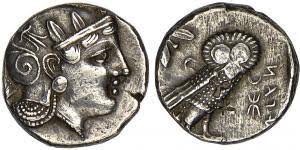
Coin of Yehud with Athenian owl
The second group belongs to the Persian period; some issues show a bearded head of a Persian king, wearing a serrated crown while another depicts national Jewish symbols such as a lily, an ear, or a shofar on the observe, with a rising bird of prey shown on the reverse (27, p. 278). An important chronological indication is provided by the image of a Persian bird of prey, representing xvarnah, "divine glory". This image is unknown on the coinage of the Achaemenid period, although it often appears on Hellenistic coins from Persis, including some where the bird is shown perched on a king's hat (7; 8). According to the New Chronology, Judea was still subject to Persian rule during the late 4th and the early 3 rd century BC period; this explains why Persian images continued to appear on its coinage long after the Macedonian invasion. The coins of Judea that were minted earlier, under King Artaxerxes resemble his crowned image while the so-called "patriotic" group bearing symbols of Jewish liberation, - a lily, an ear, a shofar, and a burning altar, - was minted in the later period by Nehemiah, who presented himself as the Jewish national leader.
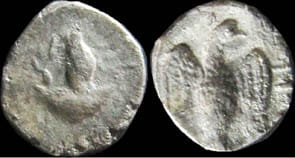
private collection M. Shick, Israel
Coin of Yehud with burning altar
_II_of_Persis.jpg)
Classical Numismatic Group, Inc. http://www.cngcoins.com [CC BY-SA 3.0], via Wikimedia Commons
Coin of Persian King with bird on his hat
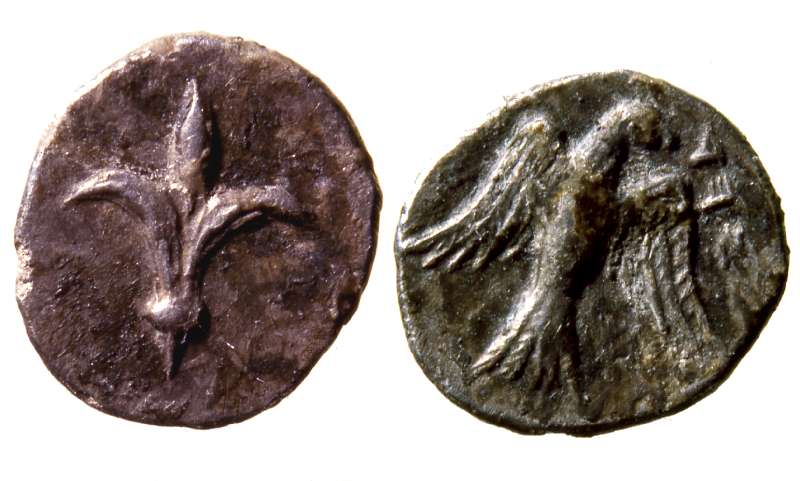
The Israel Museum
Coin of Yehud with a lily
The third group was minted with portraits of the Ptolemaic kings on the observe and the image of a Ptolemaic eagle on the reverse. One group of Ptolemaic coins shows a young male head on the observe; another group bears a portrait of Ptolemy I and a portrait of his wife Berenika; and the last group depicts a diademed head of a king (27, p. 280). According to Haim Gitler and Catharine Lober, while the coins with a young male head were minted after Ptolemy I’s conquest of Judea in 302 BC (contrary to Dan Barag’s opinion), the coins of Ptolemy and Berenika were minted between 283/2-270 BC, after the death of Ptolemy I; the last group, with the diademed head of Ptolemy, was minted under their son, Ptolemy II (15). However, Yaakov Meshorer maintained that, as Ptolemy I is known to have oppressed the Jews, he would not have permitted them to strike coinage; the privilege of operating a provincial mint would, however, have been consistent with the benevolence of Ptolemy II towards the Jews, meaning that these coins could have been minted under Ptolemy II (27, p. 19-20).
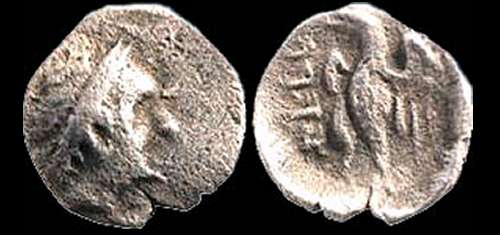
Ptolemaic coin of Yehud with diademed portrait of a king
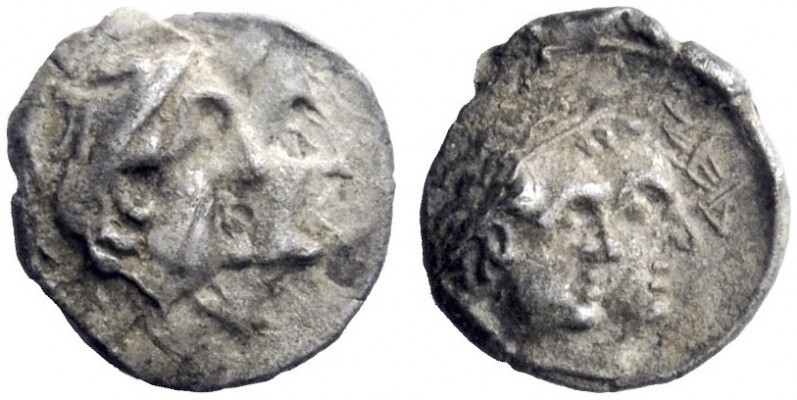
Ptolemaic coin of Yehud with Ptolemy I and Berenika, Ptolemy II and Arsinoe
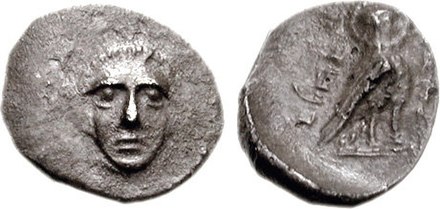
Coin of Hezekiah pehah
In addition, two types of coins of *Yehud belonging to Hezekiah are known: one shows a beardless male head on the front and a horned and winged lynx on the reverse; the other, where Hezekiah is called pehah, has a stylized frontal head with an Athenian owl on the reverse (14; 27, p. 279). The metrological study of these coins prepared by Yigal Ronen dates them to the Ptolemaic period because their weight corresponds to the system of Attic coinage accepted by the Ptolemies. It was thus suggested by Gitler that these coins date from the transitional period from 332 BC up until the Ptolemaic conquest in 302 BC (14). However, it remains unclear why the governor of Judea, who served after the Macedonian conquest when the Achaemenid Empire ceased to exist, would have used the Persian title. There is no reason to believe that the Aramaic name *Yehud corresponded to the name of the Achaemenid province of Judea, as is usually claimed. However, the name *Yehud found on the Aramaic seals and bullae from the unprovenanced post-exile archive published by Nahman Avigad (1), can be compared to the impressions in the Paleo-Hebrew script that were sealed on hundreds of jar-handles, - these were excavated in the Jewish Quarter of Jerusalem, in Bethany, and particularly in Ramat Rachel, allegedly the seat of the Persian governor of the province of Judea. These jar handles are dated by ceramics analysis to the early Hellenistic period, and on some examples the name of Yehoezer pehah is mentioned. It should also be noted that a group of Aramaic bullae from Ramat Rachel includes one that mentions Elnathan pehah (40). However, the question remains: what were the dates of these, otherwise unknown, governors of Judea?
It is known that Nehemiah remained in charge until at least the thirty-second year of King Artaxerxes’ reign (290 BC), but it is possible that he could have retained power until the arrival of Ezra (275 BC), thereby authenticating the text of Nehemiah 8 that brought Nehemiah and Ezra together. It, therefore, seems probable that these otherwise unknown governors of Judea, named pehah, in fact followed Bagoas and predated Nehemiah, remaining in charge during the period before the time of Ptolemy I’s attack. Hezekiah pehah was probably the last governor of Judea, who served before pehah Nehemiah, until the time of Ptolemy I’s attack on Jerusalem. A single piece of evidence indicating that the Persian administration of Judea continued during Ptolemy I’s conquest is found on a rare coin that depicts a similar head facing, as shown on the coins of Hezekiah pehah, but with a Ptolemaic eagle on the reverse. The figure of Hezekiah pehah may be identified as Hezekiah, the first Jewish historian who, according to Josephus, emigrated to Egypt after Ptolemy I’s attack (3, p. 82-91).
Additionally, a unique coin with a stylized head facing, like that on Hezekiah pehah’s coins, records the name of the High Priest Johanan. Since, according to Nehemiah 12:22-23, the High Priest Johanan, the grandson of Elyashiv, served during the Persian period, it seems likely that he was the same person referred to in the Elephantine Petition, and possibly also featured in the story of Josephus on the rise of the Tobiades dynasty.
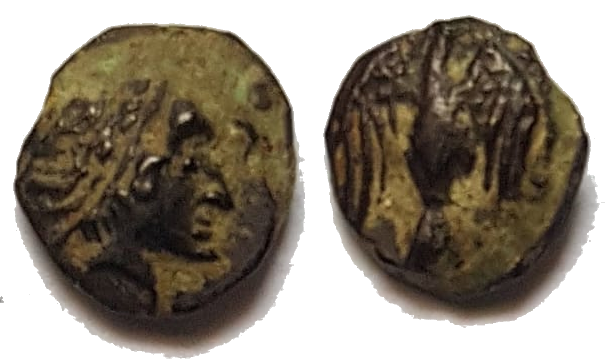
private collection M. Shick, Israel
Coin of Yehud with portrait of Ptolemy II and Persian bird of prey
More importantly, a unique coin from a private Israeli collection displays a diademed portrait of Ptolemy on the front, with the image of a Persian bird of prey, xvarnah, shown on the reverse; it follows that the issue of this coin can be regarded as the transitional mint from the Persian to the Ptolemaic period. The issue of this coin clearly demonstrates that there was no significant gap between the Persian and the Ptolemaic periods and that the Persian period could not possibly predate the Macedonian invasion. Furthermore, it proves that some of the Persian coins of *Yehud might have been issued very close to the time of the Ptolemaic conquest of Judea. Gitler and Lober agreed that the coins of *Yehud with a diademed portrait of Ptolemy I and those with Ptolemy I and Berenika, as well as the other group of coins featuring their portraits shown together on the observe with the portraits of Ptolemy II with his wife, Arsinoe II, on the reverse, were minted under Ptolemy II, copying similar coins of Egypt. This means that not only were the mints of *Yehud with the portrait of Ptolemy I issued under Ptolemy II, but that the Persian period must predate the time of Ptolemy II.
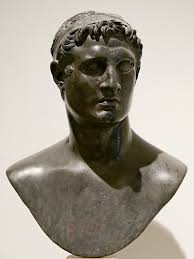
King Ptolemy II
Establishing precise dates for the Ptolemaic conquest of Judea is problematic, but regardless of whether Ptolemy I’s attack on Jerusalem occurred in 312/11 or in 302 BC, he was interested only in oppressing the Jews and taking them as captives. Nonetheless, the demographic situation improved significantly when Persian control of Judea was restored, but it is only when Judea was released from Persian rule around 270 BC, under Ptolemy II, that the population of Judea was finally incorporated into the socio-economic structure of Egypt. According to the Letter to Aristeas quoted by Josephus, Ptolemy II largely favoured the Jews, and not only initiated the translation of the Hebrew Bible into Greek but also permitted thousands of Jewish exiles to return to their land. The last event was traditionally dated by many scholars to c. 270 BC, although according to Josephus XII:1.11, it happened when Antigonus II was defeated by Ptolemy II, c. 260 BC, at around the same time that Ptolemy II issued his decrees concerning the socio-economic regulations for the region of Coele-Syria that were preserved among the Rainer Papyri in Vienna (19, p. 135-6); this can also be verified by the letters from the Zenon Archive that date from 259 BC.
12. Conclusion
The New Chronology of ancient Jewish history establishes a new timeline for the history of the Judean Kingdom that is largely corroborated by the archaeological data provided by Israel Finkelstein. Working with the new timeline, which moves the traditionally accepted dates forward by almost 250 years, the Kingdom of Judea ruled by David and Solomon and centred in Jerusalem would have been established in the 730s BC, soon after the total destruction of the Kingdom of Israel by the Assyrians in 733/2 BC. The Kingdom of Judea continued to exist throughout the Achaemenid period as a small, semi-independent kingdom and survived the destruction of Samaria; it enjoyed brief periods of political independence, first, under King Hezekiah, c. 479-465 BC, and later under King Josiah, c. 373-360 BC. Under King Josiah, c. 373 BC, the High Priest Hilkiah issued the Books of the Torah for the first time. After the death of King Josiah, Judea continued as a semi-independent protectorate under the Egyptians until its ultimate demise as a result of the continuous attacks by the Achaemenid King Artaxerxes III Ochus, who was known to the Biblical writers as Nebuchadnezzar, the king of Babylon. At this time, in 350 and 340 BC, the Jews were sent into exile in Babylon and Hyrcania, with the destruction of the Temple of Jerusalem occurring in 339 BC. Already in 335 BC, Darius III allowed the first group of exiles to return to their land with Zerubbabel; they rebuilt the sacrificial altar and initiated the Temple’s building.
The Achaemenid Empire was conquered by Alexander the Great in 332 BC and following his death in 323 BC, the territory of his kingdom was divided up by his generals, the Diadochi; the region of Judea then entered a period of turbulence. Around 302 BC, King Artaxerxes, the fratarakā of Persis, succeeded in restoring Persian control over Coele-Syria – including Judea – and appointed his "cupbearer" Nehemiah as governor of Jerusalem; he arrived from Susa accompanied by a group of exiles, and focused on rebuilding Jerusalem. In 275 BC, being actively supported by Artaxerxes, Ezra brought the remaining exiles back from Babylon to their homeland, thus ending the seventy-year period of exile as prophesied by Jeremiah. This suggested sequence of events makes it possible to date the final return of the Jews from the Babylonian exile towards the early Hellenistic period. As a result of the return of the Jews en masse, the demographic situation changed, leading to a period of economic and political prosperity in Judea. The primary edition of the Hebrew Bible, issued by Ezra, must be dated to the same period, c. 275-70 BC; at around the same time it was translated into Greek in Alexandria and became known as the Septuagint.
Selected Literature
- 1. N. Avigad: Bullae and Seals from a Post-Exilic Judean Archive, in: Qedem, vol. 4, 1976, p. 1-36.
- 2. D. Barag: The Effects of Tennes Rebellion on Palestine, in: Bulletin of the American School of Oriental Research, vol. 183, 1966, p. 6-12.
- 3. B. Bar-Kochba: Pseudo-Hecateus on the Jews. Legitimizing the Jewish Diaspora. University of California Press, 1997.
- 4. Th. Bergren: Nehemiah in 2 Maccabees 1:10 – 2.18, in: Journal for the Study of Judaism in the Persian, Hellenistic, and Roman Period, vol. 28, 1997, p. 249-70.
- 5. A. Biran and J. Naveh: The Tel Dan Inscription: A New Fragment, in: Israel Exploration Journal, vol. 45, no. 1, 1995, p. 1-18.
- 6. T. Boiy: Late Achaemenid and Hellenistic Babylon. Leuven – Paris – Dudley, 2004.
- 7. V. Curtis: The Frataraka Coins of Persis: Bridging the Gap between Achaemenid and Sasanian Persia, in: World of Achaemenid Persia. London, 2010, p. 379-394.
- 8. Ibid: Religious Iconography on Ancient Iranian Coins, in: After Alexander: Central Asia before Islam, eds. J. Cribb and G. Herrmann, Oxford, 2007, p. 413-434.
- 9. Ph. Davies: Memories of Ancient Israel. Louisville and Kentucky, 2008.
- 10. J. Dušek: The Importance of the Wadi Daliyeh Manuscripts for the History of Samaria and the Samaritans, in: Protestant Theological Faculty, Religions, vol. 11 (2), 2020, p. 1-13.
- 11. I. Finkelstein: The Quest for the Historical Israel: Debating Archaeology and the History of Early Israel. Atlanta, 2007.
- 12. Ibid: The Forgotten Kingdom. The Archaeology and History of Northern Israel. Atlanta, 2013.
- 13. Ibid: Hasmonean Realities behind Ezra, Nehemiah, and Chronicles. Atlanta, 2018.
- 14. H. Gitler and C. Lorber: A New Chronology for the Yehizkiyahu coins of Judah, in: Swiss Numismatic Revue, vol. 87, 2008, p. 61-82.
- 15. Ibidem: A New Chronology for the Ptolemaic Coins of Judah, in: American Journal of Numismatics, vol. 18, 2006, p. 1-41.
- 16. K. Gholami: A Revisited Frataraka Chronology and Coinage, in: Ancient Iranian Numismatics. In Memory of David Sellwood, ed. M. Fagfoury, 2020, p. 135-156.
- 16. E. Gmirkin: Berossus and Genesis, Manetho and Exodus. Copenhagen, 2006.
- 16a. Ibid: Plato and the Creation of the Hebrew Bible. London and New York, 2017.
- 16b. Ibid: ‘Solomon’ (Shalmaneser III) and the Emergence of Judah as an Independent Kingdom, in: Biblical Narratives, Archaeology and Historicity Essays in Honour of Thomas L. Thompson , eds. L. Niesiolowski-Spano and E. Pfoh, London, 2020, p. 76–90.
- 17. L. Grabbe: 1 and 2 Kings. An Introduction and Study Guide. London, Bloomsbury, 2017.
- 18. Ibid: Reconstructing History from the Book of Ezra, in: Second Temple Studies. 1. Persian Period, ed. P.R. Davies. Sheffield, 1992, p. 98-106.
- 19. Ibid: Jewish Historiography and Scripture in the Hellenistic Period, in: Did Moses Speak Attic? Jewish Historiography and Scripture in the Hellenistic Period, ed. by L. Grabbe. Sheffield, 2001, p. 129-155.
- 20. G. Heinsohn: Empires Lost and Found: Stratigraphy and Today's Search for the Powers of the Past. University of Bremen, 2006.
- 21. O. Hoover: Overstruck Seleucid Coins, in: A. Houghton, C. Lober and O. Hoover: Seleucid Coins: A Comprehensive Catalogue, vol. 2. New York, 2008, p. 209-30.
- 22. P. Kosmin: Seeing Double in Seleucid Babylonia. Re-reading the Borsippa Cylinder of Antiochus I, in: Patterns of the Past. Oxford, 2014, p. 173-198.
- 23. I. Ladynin: Late Dynastic period, in: UCLA. Encyclopaedia of Egyptology. University of California, 2013, p. 1-13.
- 24. N. Lemche: The Old Testament: A Hellenistic Book? In: Did Moses Speak Attic? ed. by L. Grabbe, Sheffield, 2001, p. 287- 319.
- 25. E. Lipinski: On the Skirts of Canaan in the Iron Age: Historical and Topographic Researchers. Leuven, 2006.
- 26. Y. Meshorer and Sh. Qedar: Samarian Coinage. Israel Numismatic Society, 1999.
- 27. Y. Meshorer: A Treasury of Jewish Coins from the Persian Period to Bar Kokhba. Jerusalem, 2001.
- 28. W. Müseler: The Dating and the Sequence of the Persid Frataraka Revisited, in: KOINON. The International Journal of Classical Numismatic Studies, vol. I, 2018, p. 84-106.
- 29. L. G. Perdue and W. Carter, eds.: Judea/Israel under the Greek empires, in: Israel and Empire: A Postcolonial History of Israel and Early Judaism. London, 2015, p. 129-216.
- 30. B. Porten: The Elephantine Papyri in English. Atlanta, 2011.
- 31. D. Rohl: The Bible – from Myth to History. London, 2001.
- 32. Th. Römer: The So-Called Deuteronomistic History: A Sociological, Historical and Literary Introduction. London, 2005.
- 33. M. Shenkar: The Coin of the “God on the Winged Wheel”, in: BOREAS. Münsterische Beiträge zur Archäologie, ed. W. Fuchs. Munster, 2007/8, p. 13-25.
- 34. Van der Speck: Debates on the World of Berossus, in: Journal for Ancient Near Eastern and Biblical law, vol. 24, 2018, p. 137-151.
- 35. E. Sweeney: The Ramessides, Medes and Persians. New York, 2008.
- 36. I. Velikovsky: Ages in Chaos, vol. 1-5. New York, 1952.
- 37. B. Z. Wacholder: The Letter from Judah Maccabee to Aristobulus. Is 2 Maccabees 1:10b - 2:18 Authentic? In: Hebrew Union College Annual, vol. 49, 1978, p. 89-133.
- 38. J. Wiesehöfer: Fars under Seleucid and Parthian rule, in: The Age of the Parthians, eds. V. S. Curtis and S. Stewart. London, 2009, p. 37-49.
- 39. J. Wright: Rebuilding Identity: The Nehemiah Memoirs and Its Earliest Readers. Berlin, 2004.
- 40. K. L. Younger: The Fall of Samaria in Light of Recent Research, in: The Catholic Biblical Quarterly, vol. 61, no. 3, 1999, pp. 461-482.
